THE JAZZ AGE
September 30, 2017 through January 14, 2018
THE CLEVELAND MUSEUM OF ART
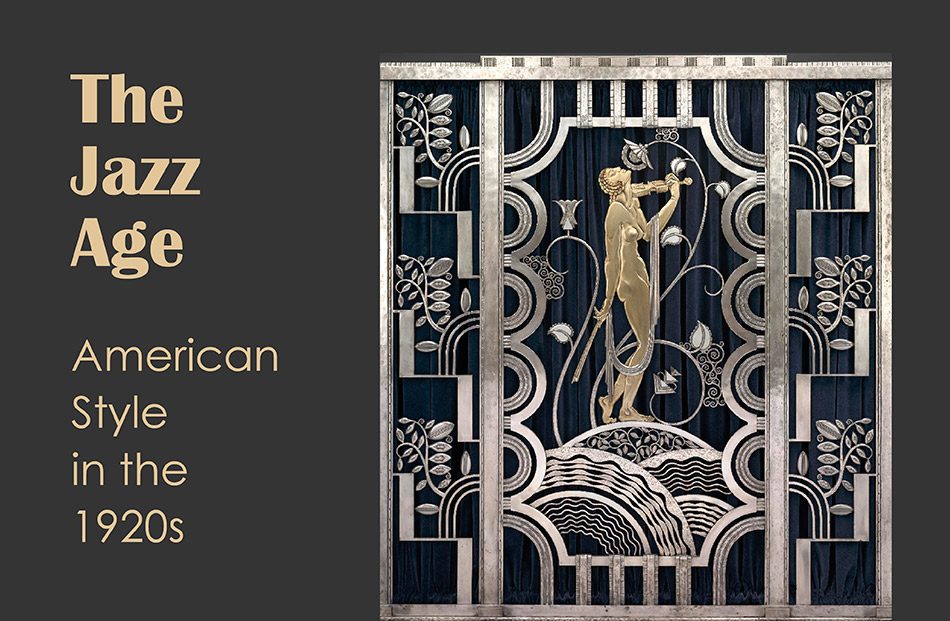 Muse with Violin Screen (detail), 1930. Paul Fehér (Hungarian, 1898–1990), designer.
Muse with Violin Screen (detail), 1930. Paul Fehér (Hungarian, 1898–1990), designer.
Rose Iron Works (American, Cleveland, est. 1904), maker
The first major museum exhibition to focus on American taste
in art and design during the 1920s and early 1930s.
More than 300 works, explore America’s cultural coming of age through an
exuberant selection of jewelry, fashion, paintings, decorative arts and motorcars.
JEWELRY
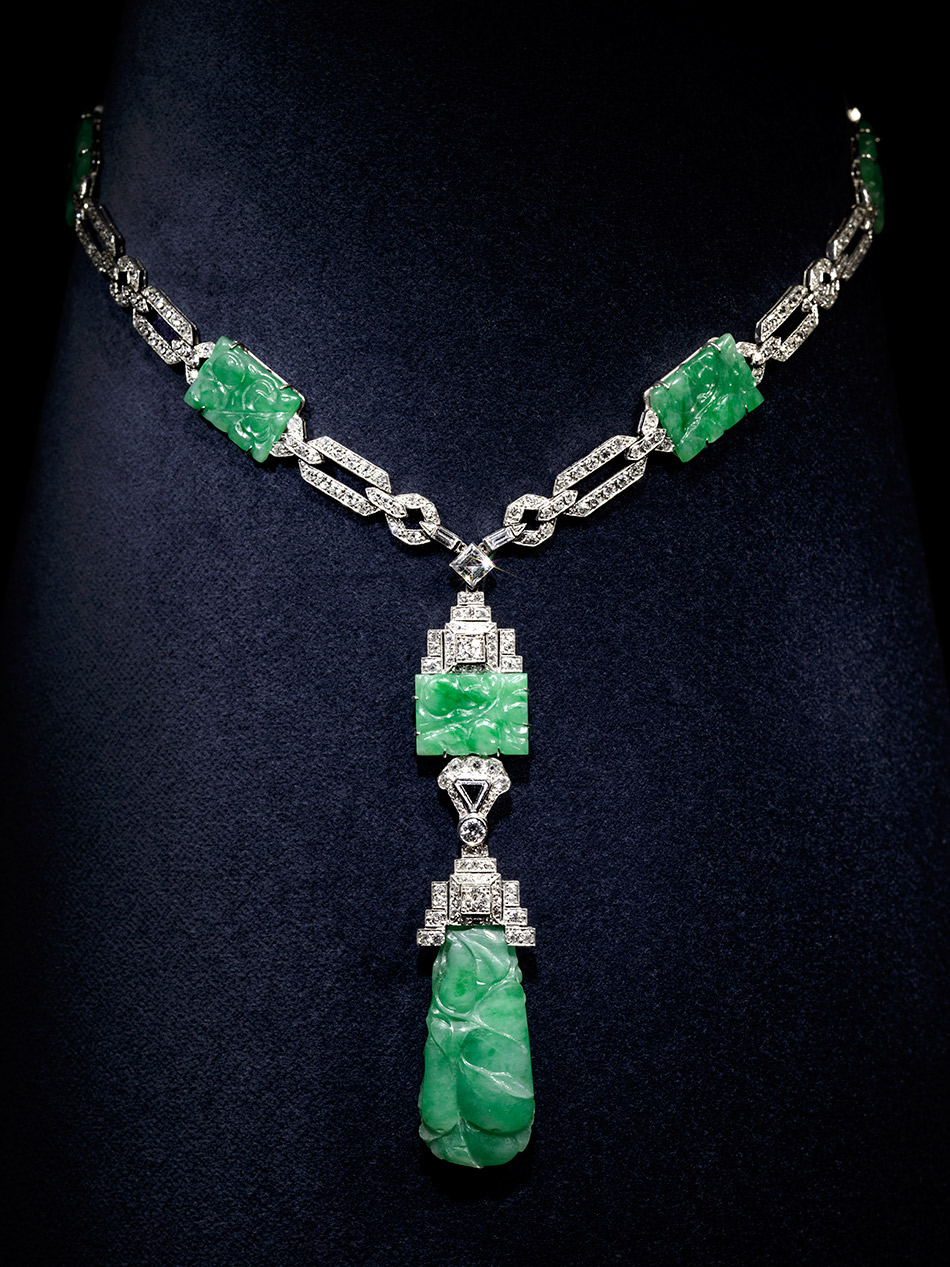 After the First World War, with the postwar map of Europe redrawn and social mores redefined, design influences merged—especially in Paris, Vienna and across the United States. New fortunes, primarily American, fueled self-indulgence and consumption, prompting design featuring vibrant colors, sumptuous materials and a unique sense of freedom.
After the First World War, with the postwar map of Europe redrawn and social mores redefined, design influences merged—especially in Paris, Vienna and across the United States. New fortunes, primarily American, fueled self-indulgence and consumption, prompting design featuring vibrant colors, sumptuous materials and a unique sense of freedom.
Necklace, c. 1920s.
Unknown maker (American).
Diamonds, platinum,
carved jade;
chain: l. 46 cm;
pendant: 9.5 x 1.1 x 0.6 cm.
Neil Lane Collection.
Photo: Gary Kirchenbauer.
 Craftsmanship and experimentation flowed back and forth across the Atlantic, with an influx of European émigré designers coming to America and American creative talent traveling and studying abroad. Organized in six sections, The Jazz Age: American Style in the 1920s explores objects affected by the purchasing power of new fortunes and new tastes, and reveals a decade marked by sharp contrasts as new ideas began to challenge traditional revival styles.
Craftsmanship and experimentation flowed back and forth across the Atlantic, with an influx of European émigré designers coming to America and American creative talent traveling and studying abroad. Organized in six sections, The Jazz Age: American Style in the 1920s explores objects affected by the purchasing power of new fortunes and new tastes, and reveals a decade marked by sharp contrasts as new ideas began to challenge traditional revival styles.
Brooch, c. 1920s.
Oscar Heyman & Bros.
(American, New York, est. 1912). Diamonds, platinum;
7.2 x 4.5 x 0.9 cm.
Neil Lane Collection.
Photo: Gary Kirchenbauer.
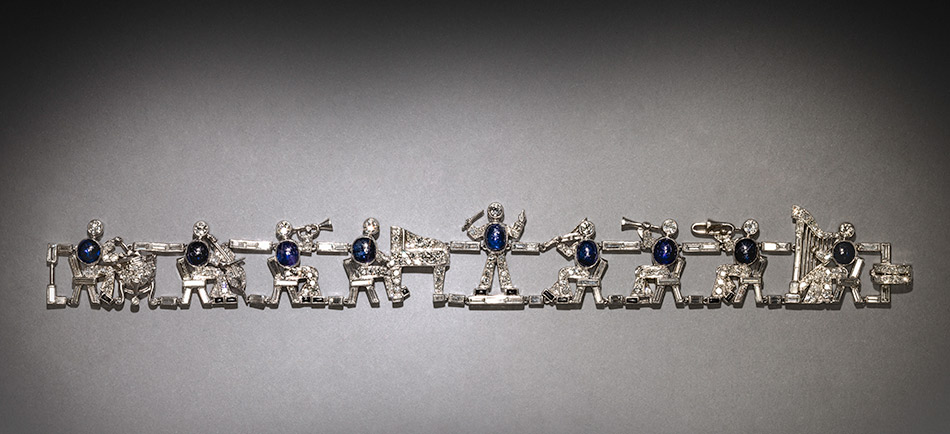 Orchestra Bracelet, c. 1930s. Unknown. Diamonds, platinum, cabochon sapphires, carved onyx; 18 x 2 x 0.5 cm. Neil Lane Collection. Photo: Gary Kirchenbauer.
Orchestra Bracelet, c. 1930s. Unknown. Diamonds, platinum, cabochon sapphires, carved onyx; 18 x 2 x 0.5 cm. Neil Lane Collection. Photo: Gary Kirchenbauer.
 LEFT: Pair of Airplane Brooches, 1930s. Cartier (French, Paris, est. 1847). Diamonds, platinum; l. 3.3–4 cm. Neil Lane Collection. Photo: Gary Kirchenbauer.RIGHT: Bracelet, c. 1920s. Attributed to Mauboussin (French, Paris, est. 1827). Diamonds, platinum, rubies; 17.8 x 2.5 x 0.4 cm. Neil Lane Collection. Photo: Gary Kirchenbauer.
LEFT: Pair of Airplane Brooches, 1930s. Cartier (French, Paris, est. 1847). Diamonds, platinum; l. 3.3–4 cm. Neil Lane Collection. Photo: Gary Kirchenbauer.RIGHT: Bracelet, c. 1920s. Attributed to Mauboussin (French, Paris, est. 1827). Diamonds, platinum, rubies; 17.8 x 2.5 x 0.4 cm. Neil Lane Collection. Photo: Gary Kirchenbauer.
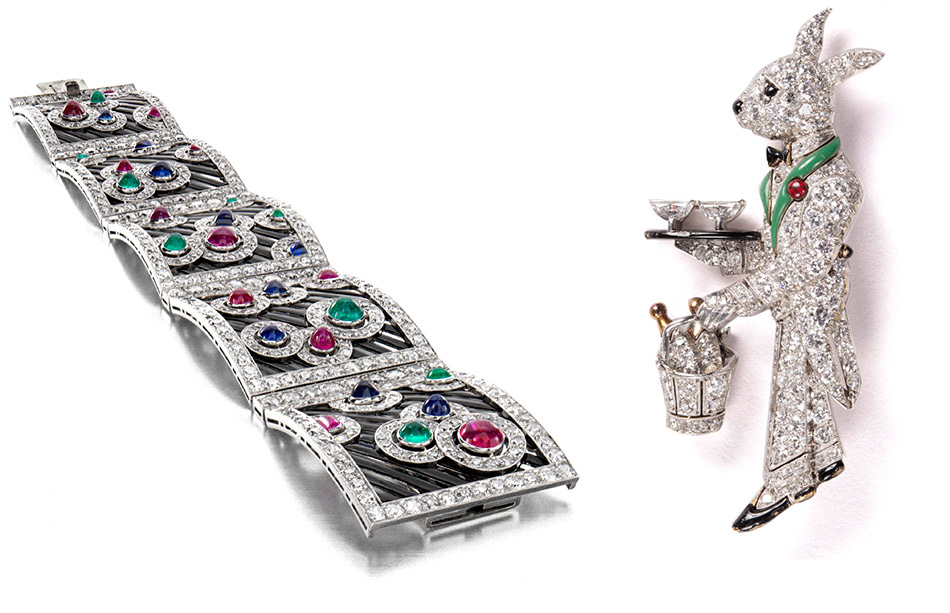 LEFT: Bracelet, 1925. Boucheron (French, Paris, est. 1858). Platinum, gold, osmium, diamonds, rubies, sapphires, emeralds, enamel; 20 x 3.2 cm. Siegelson, New York. Photo: Siegelson, New York.
LEFT: Bracelet, 1925. Boucheron (French, Paris, est. 1858). Platinum, gold, osmium, diamonds, rubies, sapphires, emeralds, enamel; 20 x 3.2 cm. Siegelson, New York. Photo: Siegelson, New York.
RIGHT: Brooch, 1929. Raymond C. Yard (American, New York, est. 1922). Diamonds, emeralds, ruby, platinum, onyx; 4.5 x 1.9 x 0.6 cm. Vartanian & Sons. Photo: Matt Flynn.
A New Look for Familiar Forms.
Extraordinary art objects using lavish craftsmanship,
exotic materials and high technical skill
Often invoking earlier French styles but with pared-down form. This trend influenced American manufacturers, while silver and jewelry design forged an important connection between traditional techniques and new influences.
Simple shapes and minimalistic decoration defined modernism in the first half of the 1920s, as well as the use of bold geometric shapes that took hold in the latter half of the decade. These abstracted and often fragmented shapes were influenced by fine art movements such as Cubism, but they also emanated from architectural sources as diverse as the stepped shapes of ancient Mayan temples, the setback profiles of skyscrapers and the open-plan arrangements of interior spaces, especially those of Frank Lloyd Wright.
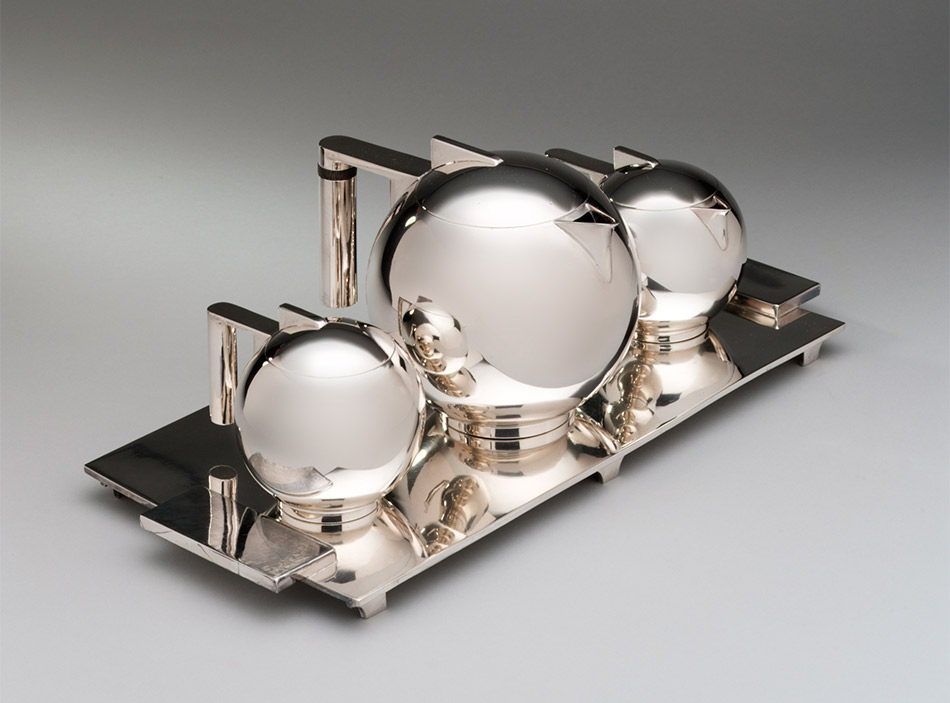 Four-Piece Tea Service, 1934. Paul A. Lobel (American, b. Romania, 1899–1983), designer. International Silver Company, Wilcox Silver Plate Company Division (American, Meriden, CT, 1898–c. 1960), maker. Electroplated nickel silver, wood; tray: 2.5 x 45.8 x 20.6 cm; sugar bowl: 10.2 x 10.2 x 14 cm; teapot: 15.2 x 15.2 x 21 cm; creamer: 10.2 x 10.2 x 14 cm. The Metropolitan Museum of Art, Gift of M. H. Lobel and C. H. Lobel, 1983, 1983.493.1–4. Image: © The Metropolitan Museum of Art. Image source: Art Resource, NY.
Four-Piece Tea Service, 1934. Paul A. Lobel (American, b. Romania, 1899–1983), designer. International Silver Company, Wilcox Silver Plate Company Division (American, Meriden, CT, 1898–c. 1960), maker. Electroplated nickel silver, wood; tray: 2.5 x 45.8 x 20.6 cm; sugar bowl: 10.2 x 10.2 x 14 cm; teapot: 15.2 x 15.2 x 21 cm; creamer: 10.2 x 10.2 x 14 cm. The Metropolitan Museum of Art, Gift of M. H. Lobel and C. H. Lobel, 1983, 1983.493.1–4. Image: © The Metropolitan Museum of Art. Image source: Art Resource, NY.
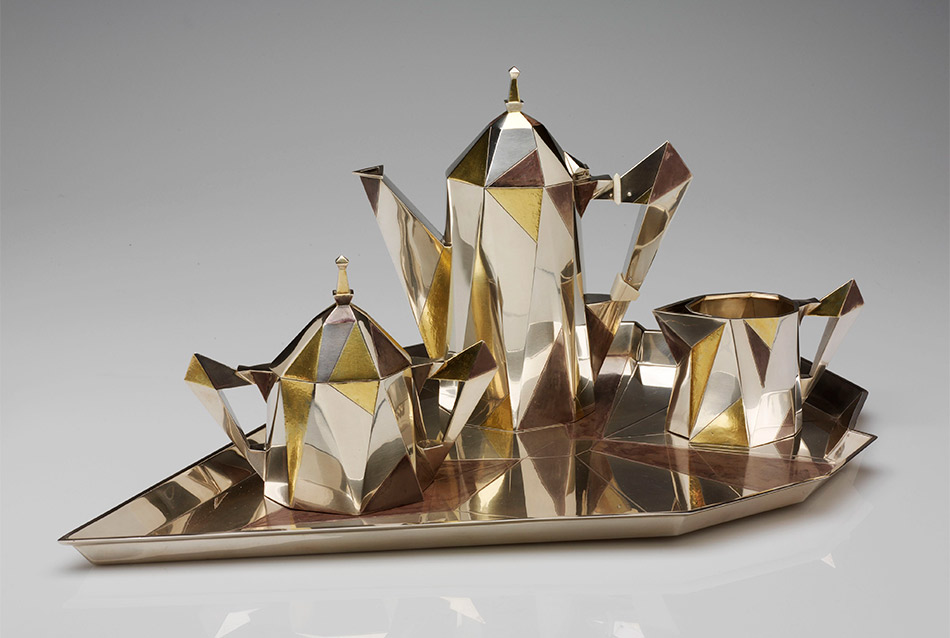 Cubic Coffee Service, 1927. Erik Magnussen (Danish, 1884–1961), designer. Gorham Manufacturing Company (American, Providence, RI, 1865–1967), maker. Silver with gilding, ivory; 24.1 x 54.6 x 34 cm. Museum of Art, Rhode Island School of Design, The Gorham Collection, Gift of Textron Inc., 1991.126.488. Photo: Erik Gould, Courtesy of the Museum of Art, Rhode Island School of Design, Providence.
Cubic Coffee Service, 1927. Erik Magnussen (Danish, 1884–1961), designer. Gorham Manufacturing Company (American, Providence, RI, 1865–1967), maker. Silver with gilding, ivory; 24.1 x 54.6 x 34 cm. Museum of Art, Rhode Island School of Design, The Gorham Collection, Gift of Textron Inc., 1991.126.488. Photo: Erik Gould, Courtesy of the Museum of Art, Rhode Island School of Design, Providence.
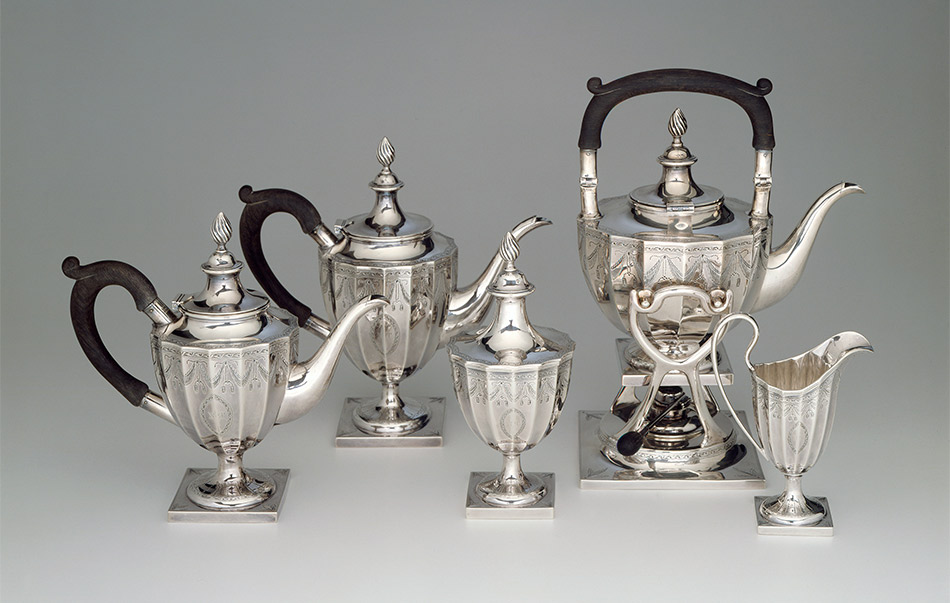 Five-Piece Coffee and Tea Service, 1929. George Christian Gebelein (American, b. Germany, 1878–1945), designer. Gebelein Silversmiths (American, Boston, 1908–c. 1960), maker. Silver, ebonized wood; tea kettle on stand: 14.5 x 24.5 x 15.6 cm; coffee pot: 25.2 x 25.2 cm; covered sugar bowl: h. 21 cm; creamer: 16 x 6.3 x 11.5 cm; teapot: 22.3 x 11.2 x 24 cm. Museum of Fine Arts, Boston, Anonymous Gift, 1986.778–782. Photo: © 2017 Museum of Fine Arts Boston.
Five-Piece Coffee and Tea Service, 1929. George Christian Gebelein (American, b. Germany, 1878–1945), designer. Gebelein Silversmiths (American, Boston, 1908–c. 1960), maker. Silver, ebonized wood; tea kettle on stand: 14.5 x 24.5 x 15.6 cm; coffee pot: 25.2 x 25.2 cm; covered sugar bowl: h. 21 cm; creamer: 16 x 6.3 x 11.5 cm; teapot: 22.3 x 11.2 x 24 cm. Museum of Fine Arts, Boston, Anonymous Gift, 1986.778–782. Photo: © 2017 Museum of Fine Arts Boston.
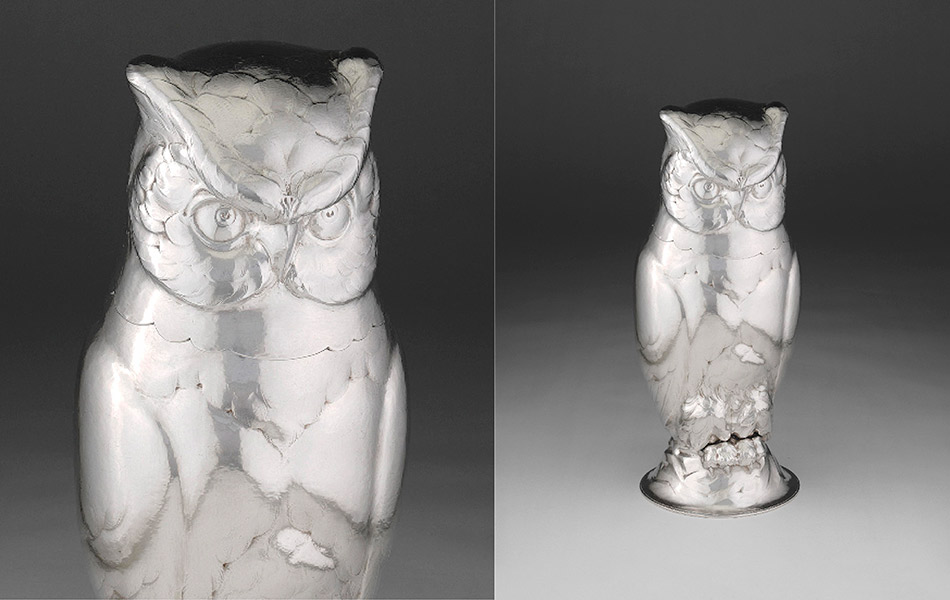 Cocktail Shaker, 1931. Peer Smed (American, 1878–1943). Silver; h. 39.3 cm. The Art Institute of Chicago, Restricted gift of Quinn E. Delaney; Wesley M. Dixon Jr. Fund, 1990.179.
Cocktail Shaker, 1931. Peer Smed (American, 1878–1943). Silver; h. 39.3 cm. The Art Institute of Chicago, Restricted gift of Quinn E. Delaney; Wesley M. Dixon Jr. Fund, 1990.179.
 Two-Handled Cup, c. 1922. Josef Hoffmann (Austrian, 1870–1956), designer. Wiener Werkstatte (Austrian, Vienna, 1903–32). Brass; 18.8 x 27.9 x 18.3 cm. The Cleveland Museum of Art, Andrew R. and Martha Holden Jennings Fund, 1983.71.
Two-Handled Cup, c. 1922. Josef Hoffmann (Austrian, 1870–1956), designer. Wiener Werkstatte (Austrian, Vienna, 1903–32). Brass; 18.8 x 27.9 x 18.3 cm. The Cleveland Museum of Art, Andrew R. and Martha Holden Jennings Fund, 1983.71.
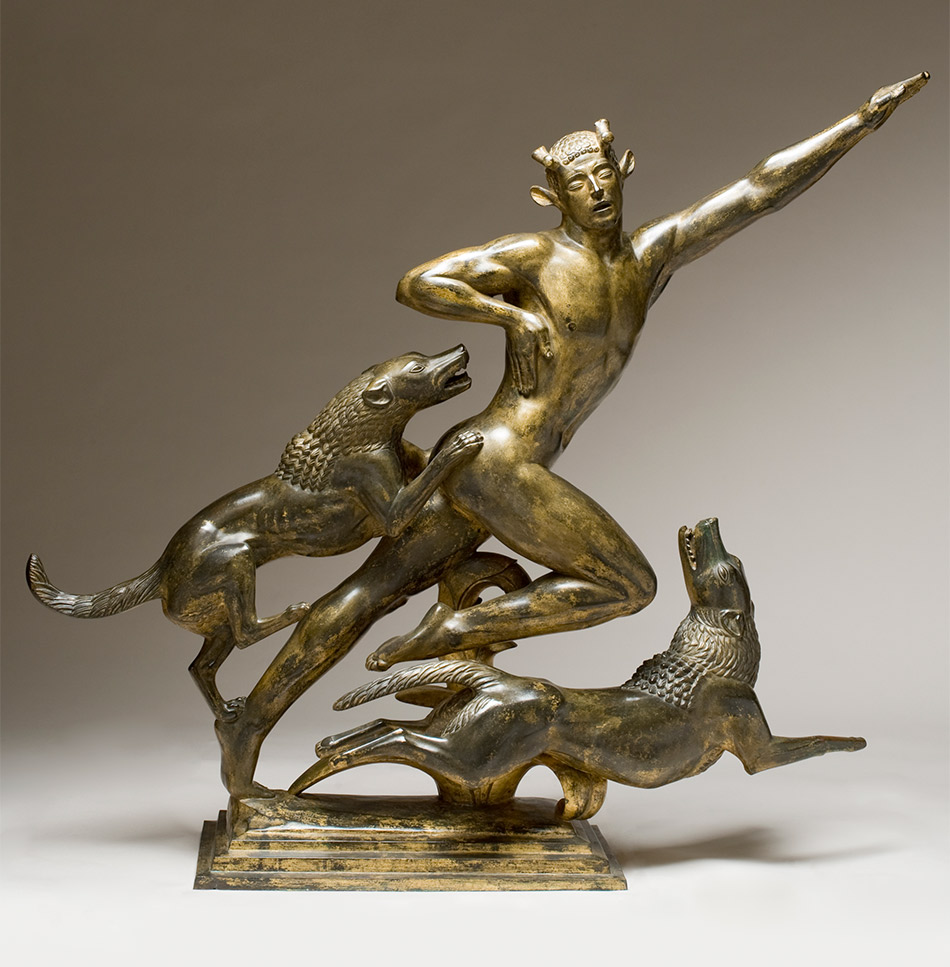 Actaeon, 1925. Paul Manship (American, 1885–1966). Gilt bronze; 120.7 x 130.8 x 33.7 cm. David Owsley Museum of Art, Frank C. Ball Collection, Gift of the Ball Brothers Foundation, 1995.035.164.
Actaeon, 1925. Paul Manship (American, 1885–1966). Gilt bronze; 120.7 x 130.8 x 33.7 cm. David Owsley Museum of Art, Frank C. Ball Collection, Gift of the Ball Brothers Foundation, 1995.035.164.
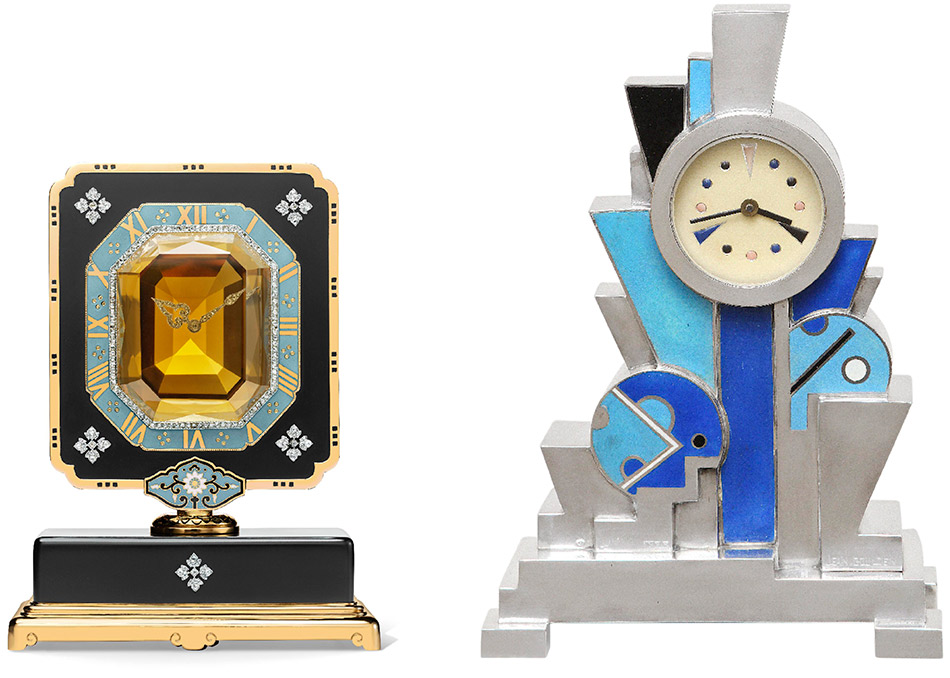
LEFT: “Mystery” Clock with Single Axle, c. 1921. Cartier (French, Paris, est. 1847). Owned by Anna Thomson Dodge. Gold, platinum, ebonite, citrine, diamonds, enamel; 12.9 x 9.7 x 4.8 cm. Cartier Collection, Inv. CM 29 C21. Photo: Marian Gerard, Cartier Collection © Cartier.
RIGHT: Clock, 1928. Jean Goulden (French, 1878–1946). Silvered bronze, colored champlevé enamel; 36.2 x 25.4 x 12.7 cm. Stephen E. Kelly / Kelly Gallery, New York. Photo: Josh Gaddy. © 2016 Artists Rights Society (ARS), New York / ADAGP, Paris.
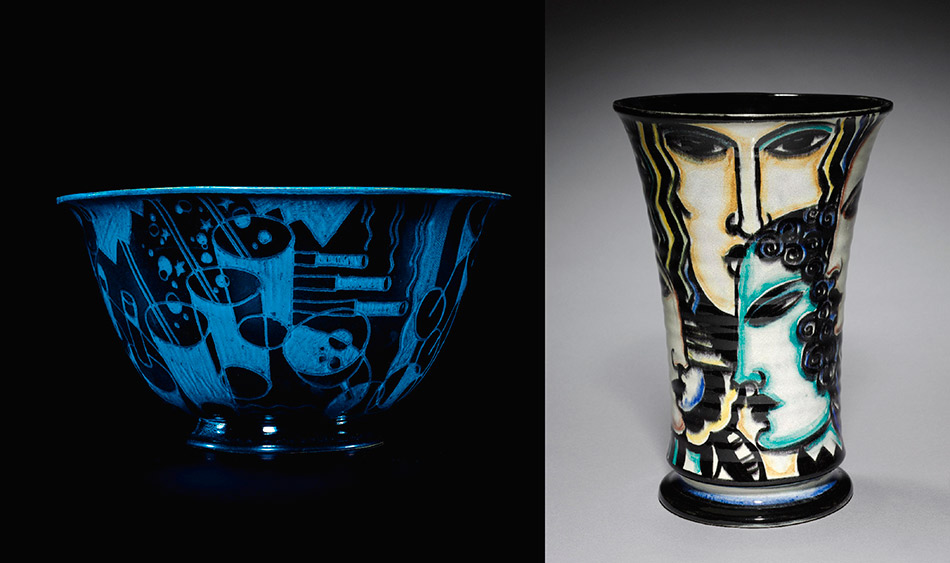 LEFT: “Cocktails and Cigarettes” Punch Bowl, 1931. Viktor Schreckengost (American, 1906–2008), designer. Cowan Pottery Studio (American, Rocky River, OH, 1912–31). Glazed earthenware with engobe, sgraffito; h. 23.5 cm, diam. 42.8 cm. The Cleveland Museum of Art, Gift of Elizabeth Mather McMillan, 2000.128. Viktor Schreckengost™ with permission from American da Vinci, LLC.RIGHT: Four Seasons Vase, 1931–32. Viktor Schreckengost (American, 1906–2008), designer. Cowan Pottery Studio (American, Rocky River, OH, 1912–31), maker. Earthenware; h. 29.6 cm. The Cleveland Museum of Art, Hinman B. Hurlbut Collection, 964.1932. Viktor Schreckengost™ with permission from American da Vinci, LLC.
LEFT: “Cocktails and Cigarettes” Punch Bowl, 1931. Viktor Schreckengost (American, 1906–2008), designer. Cowan Pottery Studio (American, Rocky River, OH, 1912–31). Glazed earthenware with engobe, sgraffito; h. 23.5 cm, diam. 42.8 cm. The Cleveland Museum of Art, Gift of Elizabeth Mather McMillan, 2000.128. Viktor Schreckengost™ with permission from American da Vinci, LLC.RIGHT: Four Seasons Vase, 1931–32. Viktor Schreckengost (American, 1906–2008), designer. Cowan Pottery Studio (American, Rocky River, OH, 1912–31), maker. Earthenware; h. 29.6 cm. The Cleveland Museum of Art, Hinman B. Hurlbut Collection, 964.1932. Viktor Schreckengost™ with permission from American da Vinci, LLC.
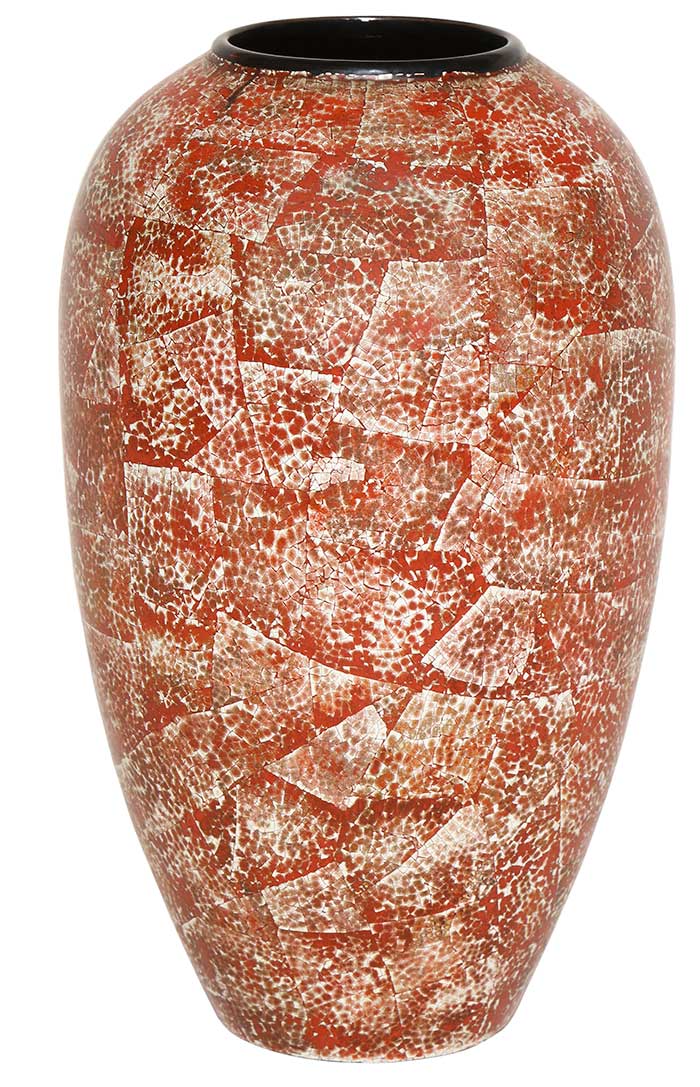 Vase, c. 1925.
Vase, c. 1925.
Jean Dunand
(French, b. Switzerland, 1877–1942).
Copper, lacquer; h. 25.7 cm,
diam. 15.9 cm.
Stephen E. Kelly / Kelly Gallery,
New York.
Photo: Josh Gaddy.
© 2017 Artists Rights Society
(ARS), New York.
FASHION
A new ideal for the young modern woman, dictating more revealing fashions and calling for colorful jewelry in exotic forms as well as accessories for cosmetics and cigarette smoking that lent additional glamour and adventure to liberated lifestyles. Fashionable people “stepped out” to nightclubs on both sides of the Atlantic to hear jazz music, which transformed traditional concert venues into dance halls and gave the era a new pulse.

Installation views of The Jazz Age: American Style in the 1920s, Photos by David Brichford
1: Kate Belinson Inc. (American, Brooklyn, NY, active 1920s) Evening Dress with Starburst and Underslip, 1927-29. Black chiffon, silver beads, lace , trim. Kent State University Museum, Silverman/Rodgers Collection, KSUM 1983.1.361.
2. Unknown Designer/Manufacturer. Evening Dress and Underslip, c. 1925. Green silk chiffon; silver, gold, and clear beads. Kent State University Museum, Gift of the Martha McCaskey Selhorst Collection, KSUM 1996.58.346a–b.
3. Unknown Designer/Manufacturer Probably American. Silk, woven gold pattern, silk floss embroidery, gold and silver beads. Metallic Evening Dress, c. 1925. Kent State University Museum, Gift of Mr. & Mrs. Albert A. Augustus, KSUM 2004.28.11. Photo: Sara Hume, Courtesy of the Kent State University Museum.
4. Gabrielle “Coco” Chanel (French, 1883–1971) House of Chanel (French, est. 1913), maker Worn by Katherine Davis Pulitzer. Dress, c. 1928. Silk chiffon and net, sequins, glass beads. Western Reserve Historical Society, Cleveland, Ohio, Gift of Mrs. William C. Weir, 83.19.8
5. Unknown Designer/Manufacturer French. Evening Dress, c. 1925. Yellow silk chiffon with gilt thread. Kent State University Museum, Gift of Mr. and Mrs. Richard Fetzer, KSUM 1986.102.1.
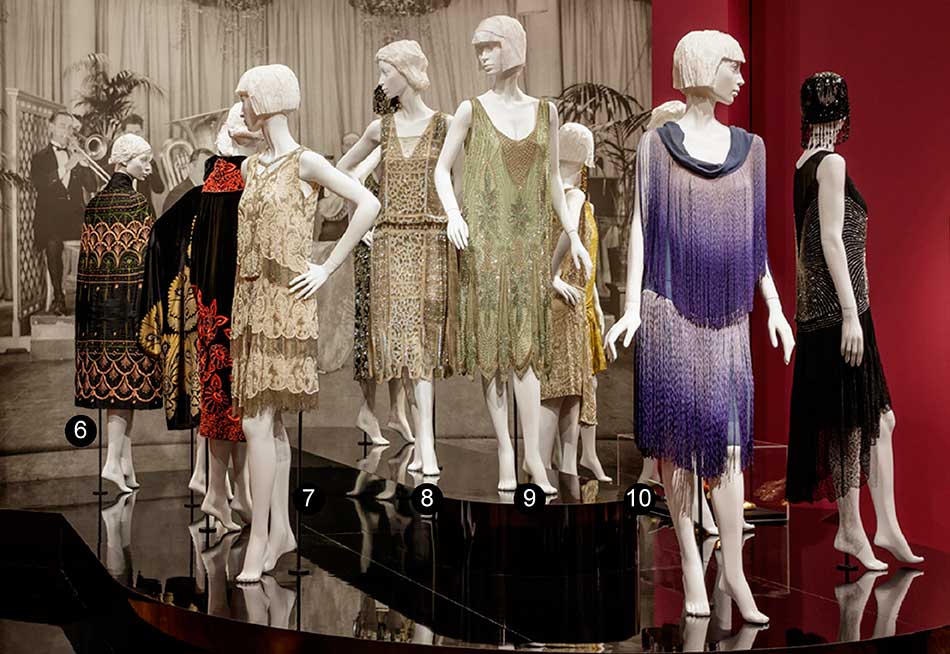
Installation views of The Jazz Age: American Style in the 1920s, Photos by David Brichford
6. Unknown Designer/Manufacturer European, Cape, c. 1920. Silk, embroidery, marabou feathers. Western Reserve Historical Society, Cleveland, Ohio, Gift of Mrs. Burton Nobil, 69.8.1.
7. Attributed to House of Worth (French, Paris, 1858–1956) Dress, 1926 Silk, glass beads. Western Reserve Historical Society, Cleveland, Ohio, Gift of Mr. Frederick C. Chandler and Mrs. Montgomery Frazier, 91.22.7.
8. Unknown Designer/Manufacturer American. Worn by Miss Ruth L. Schneider, Buffalo, NY. Wedding Dress, c. 1924. White silk with applied sequined decoration. Western Reserve Historical Society, Cleveland, Ohio, Gift of Mr. and Mrs. Walter Oswald, 69.88.1.
9. Attributed to Paul Poiret (French, 1879–1944) Evening Dress and Underslip, c. 1925. Green silk chiffon; silver, gold, and clear beads. Kent State University Museum, Gift of the Martha McCaskey Selhorst Collection, KSUM 1996.58.346a–b.
10. Gabrielle “Coco” Chanel (French, 1883–1971) House of Chanel (French, est. 1913), maker Evening. Dress and Underslip, 1926. Blue silk chiffon with applied blue ombré silk fringe. Kent State University Museum, The Helen O. Borowitz Collection, KSUM 1997.71.7ab
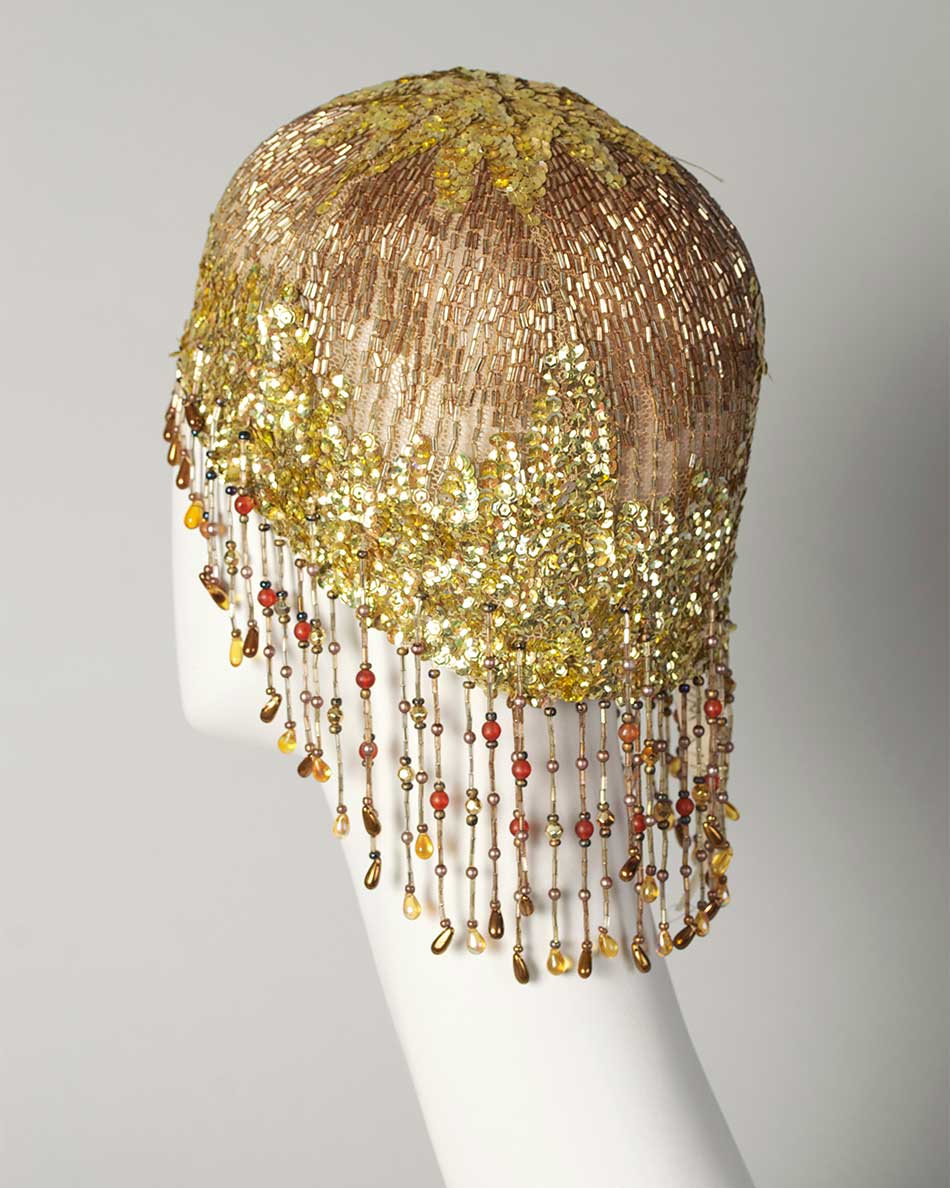 Unknown Designer/Manufacturer American. Hat (Cloche), c. 1920s. Net ground, gold beads, iridescent sequins Kent State University Museum, Silverman/Rodgers Collection, KSUM 1983.1.1658. Photo: Sara Hume, Courtesy of the Kent State University Museum.
Unknown Designer/Manufacturer American. Hat (Cloche), c. 1920s. Net ground, gold beads, iridescent sequins Kent State University Museum, Silverman/Rodgers Collection, KSUM 1983.1.1658. Photo: Sara Hume, Courtesy of the Kent State University Museum.
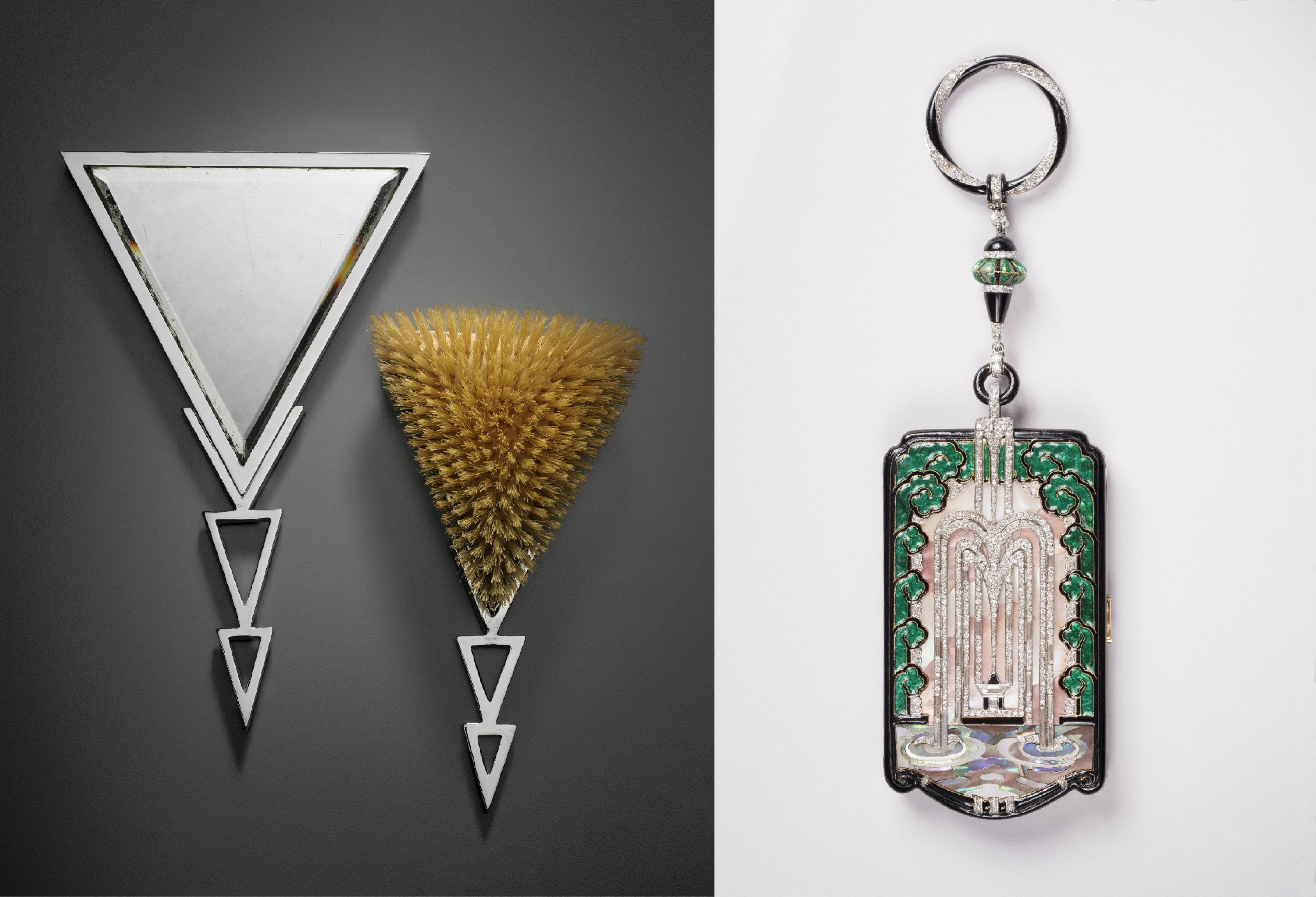 LEFT: Elsa Tennhardt (American, b. Germany, 1889–1980) E. & J. Bass Company (American, New York, c.1890–1930), maker. Vanity Mirror and Hair Brush Set, designed 1928, made c. 1928–30. Mirror: silver plate, mirror glass. Brush: silver plate, boar bristles Mirror: l. 27.5 cm. Brush: l. 24 cm. Museum of Fine Arts, Boston, The John Axelrod Collection, 2014.1290.1–2 Photo: © 2017 Museum of Fine Arts, Boston.
LEFT: Elsa Tennhardt (American, b. Germany, 1889–1980) E. & J. Bass Company (American, New York, c.1890–1930), maker. Vanity Mirror and Hair Brush Set, designed 1928, made c. 1928–30. Mirror: silver plate, mirror glass. Brush: silver plate, boar bristles Mirror: l. 27.5 cm. Brush: l. 24 cm. Museum of Fine Arts, Boston, The John Axelrod Collection, 2014.1290.1–2 Photo: © 2017 Museum of Fine Arts, Boston.
RIGHT: Mauboussin (French, Paris, est. 1827) Owned by Yvonne Printemps. Compact, 1925. Enamel, mother-of-pearl, diamonds, onyx, gold, platinum 17.8 x 5.1 x 1.3 cm Vartanian & Sons Photo: Matt Flynn.
ART
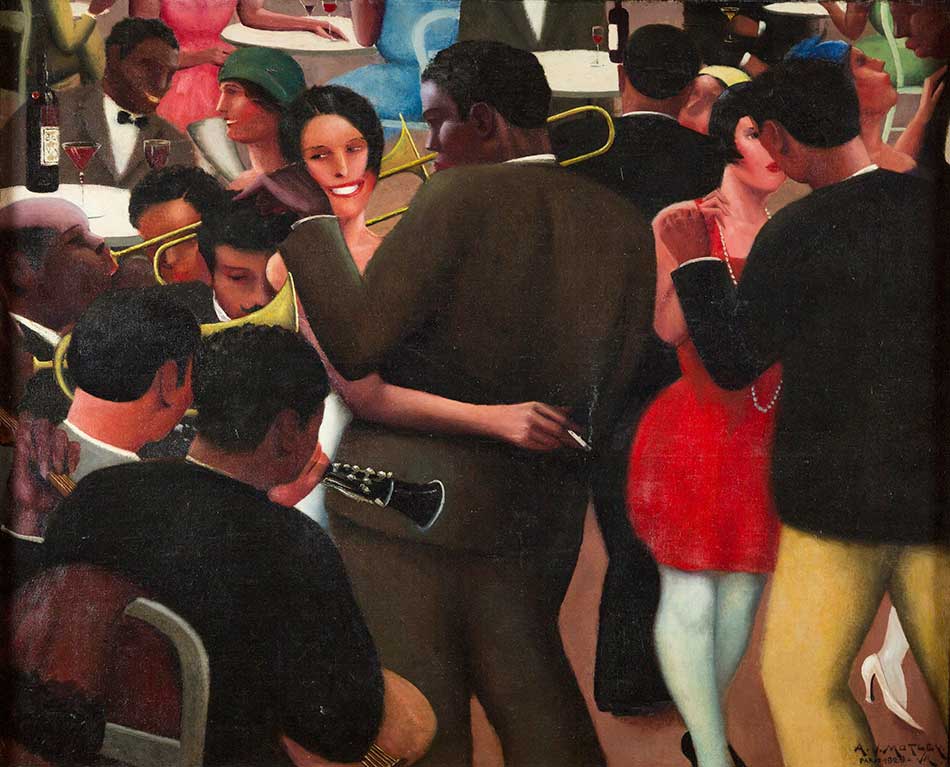 Blues, 1929. Archibald J. Motley Jr. (American, 1891–1981). Oil on canvas; 91.4 x 106.7 cm. Collection of Mara Motley, MD, and Valerie Gerrard Browne. © Valerie Gerrard Browne / Chicago History Museum / Bridgeman Images.
Blues, 1929. Archibald J. Motley Jr. (American, 1891–1981). Oil on canvas; 91.4 x 106.7 cm. Collection of Mara Motley, MD, and Valerie Gerrard Browne. © Valerie Gerrard Browne / Chicago History Museum / Bridgeman Images.
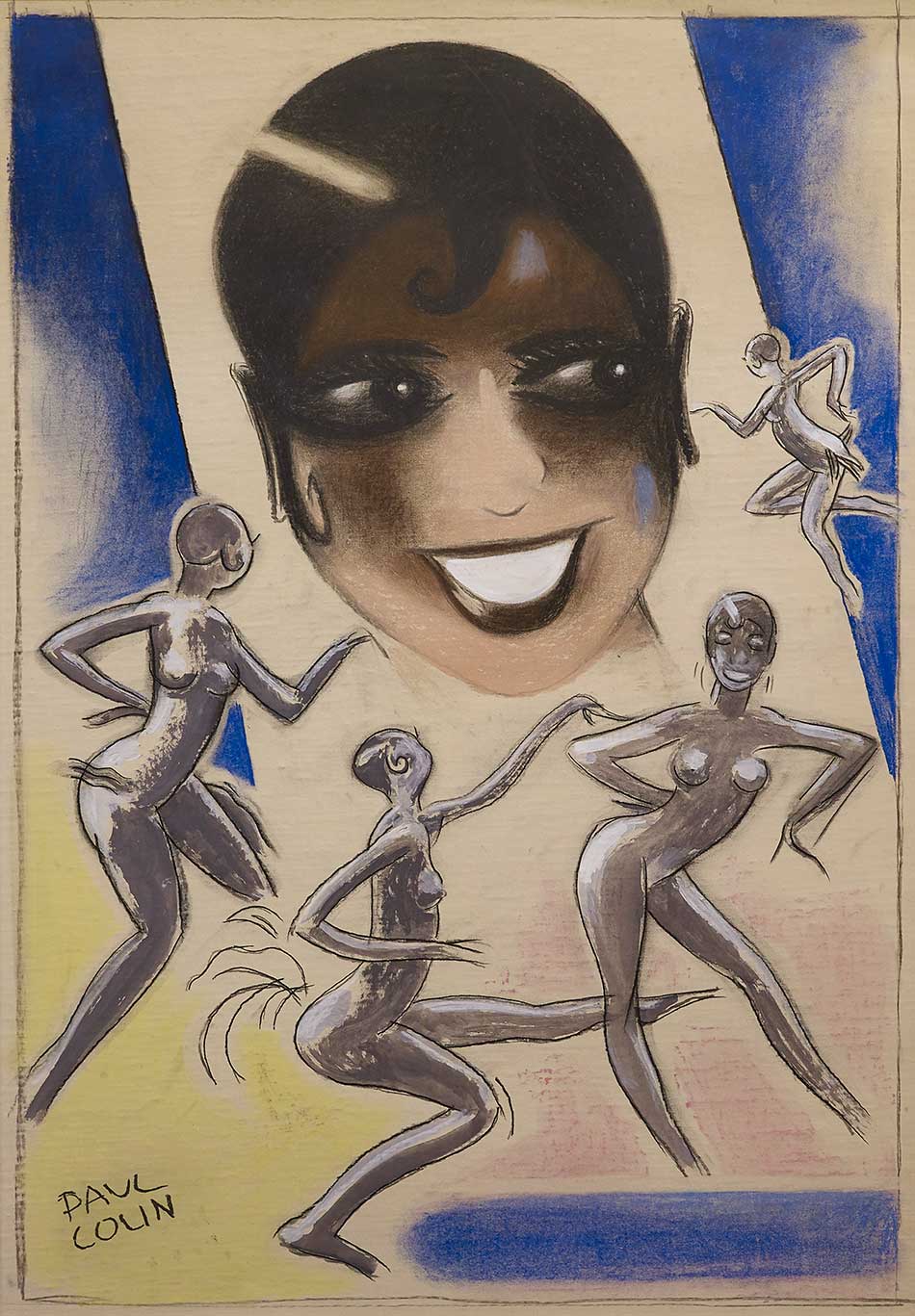 Josephine Baker / Columbia, 1930. Paul Colin (French, 1892–1985). Crayon and gouache on paper; 111.8 x 82.6 x 3.8 cm. The Collection of Richard H. Driehaus, Chicago. Photo: John Faier. © 2017 Artists Rights Society (ARS), New York / ADAGP, Paris.
Josephine Baker / Columbia, 1930. Paul Colin (French, 1892–1985). Crayon and gouache on paper; 111.8 x 82.6 x 3.8 cm. The Collection of Richard H. Driehaus, Chicago. Photo: John Faier. © 2017 Artists Rights Society (ARS), New York / ADAGP, Paris.
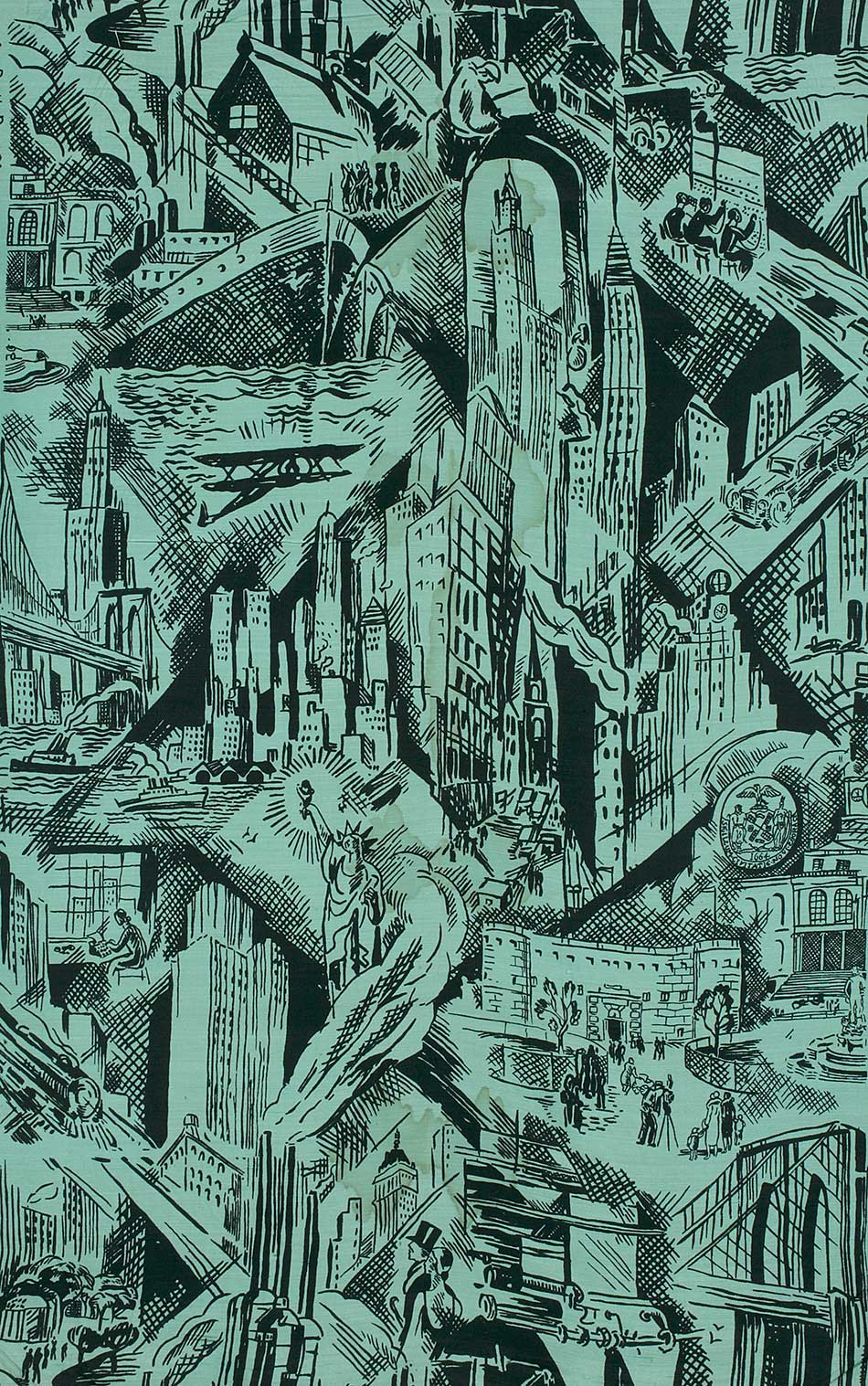 “Manhattan” Textile, 1930. Ruth Reeves (American, 1892–1966), designer. W. & J. Sloane (American, New York, 1843–1985), retailer. Silk shantung; 137.2 x 89.5 cm. Collection of the New-York Historical Society, Gift of Mrs. Bella C. Landauer, 1945.82. Photo: © New-York Historical Society.
“Manhattan” Textile, 1930. Ruth Reeves (American, 1892–1966), designer. W. & J. Sloane (American, New York, 1843–1985), retailer. Silk shantung; 137.2 x 89.5 cm. Collection of the New-York Historical Society, Gift of Mrs. Bella C. Landauer, 1945.82. Photo: © New-York Historical Society.
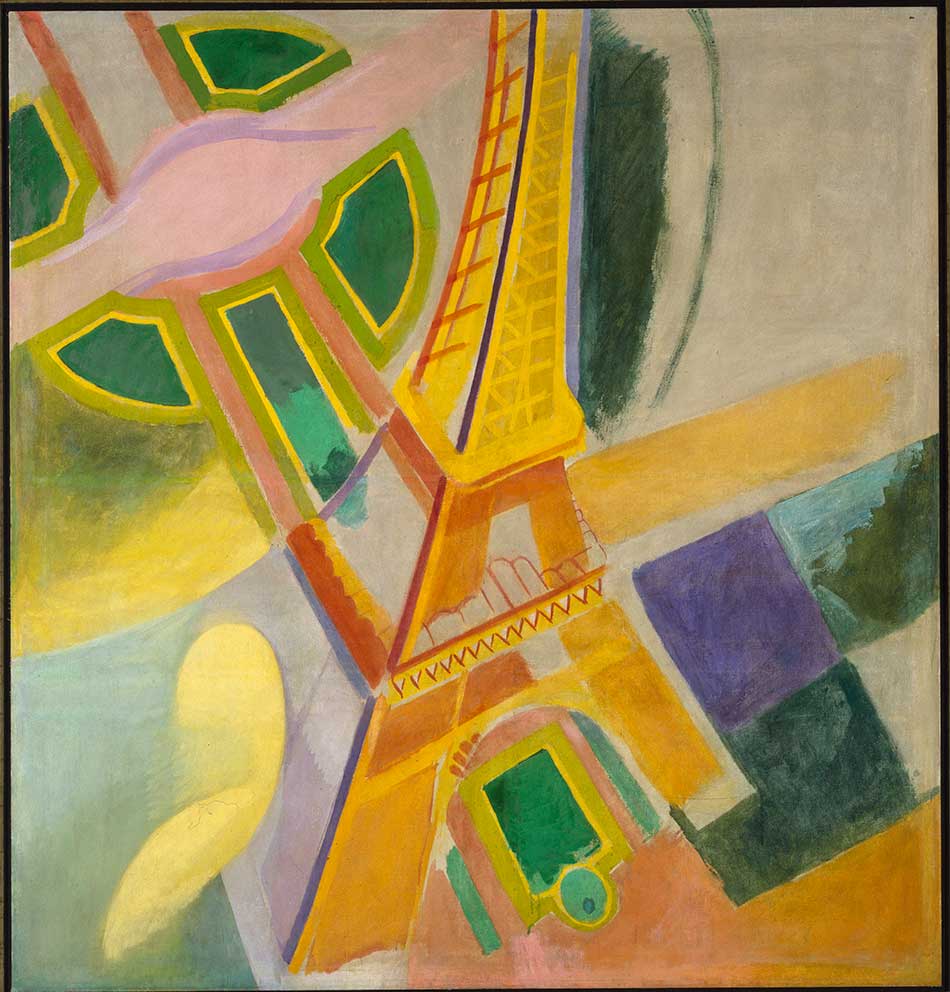 Eiffel Tower, 1924. Robert Delaunay (French, 1885–1941). Oil on canvas; 184.2 x 174.3 x 3.8 cm. Dallas Museum of Art, Gift of the Meadows Foundation, Incorporated, 1981.105.
Eiffel Tower, 1924. Robert Delaunay (French, 1885–1941). Oil on canvas; 184.2 x 174.3 x 3.8 cm. Dallas Museum of Art, Gift of the Meadows Foundation, Incorporated, 1981.105.
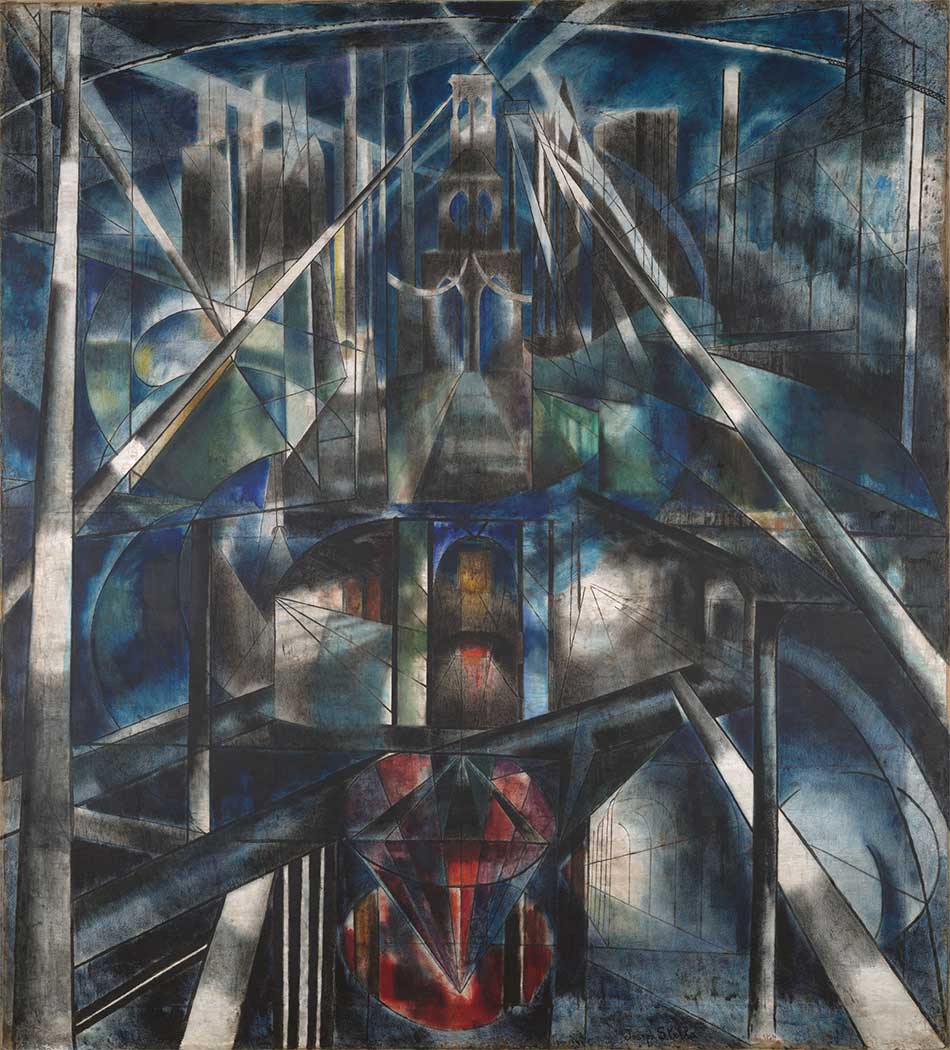 Brooklyn Bridge, 1919–20. Joseph Stella (American, b. Italy, 1877–1946). Oil on canvas; 215.3 x 194.6 cm. Yale University Art Gallery, Gift of Collection Société Anonyme, 1941.690. Photo: Yale University Art Gallery.
Brooklyn Bridge, 1919–20. Joseph Stella (American, b. Italy, 1877–1946). Oil on canvas; 215.3 x 194.6 cm. Yale University Art Gallery, Gift of Collection Société Anonyme, 1941.690. Photo: Yale University Art Gallery.
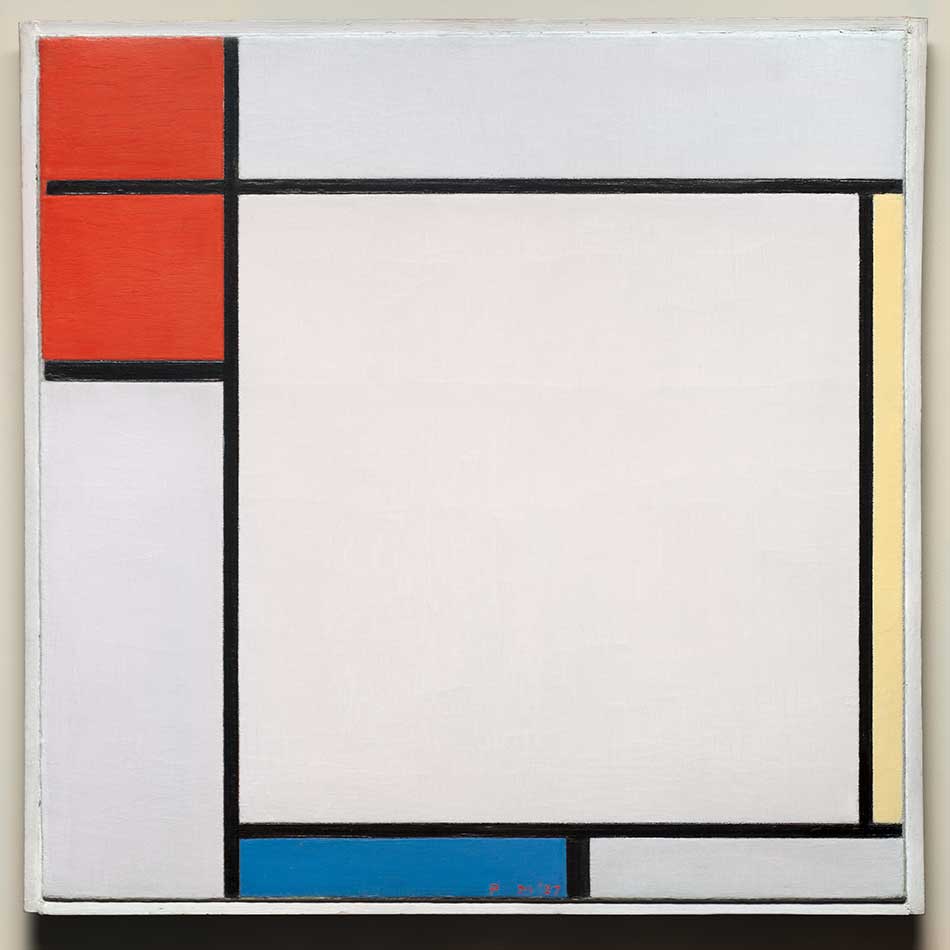 Composition with Red, Yellow, and Blue, 1927. Piet Mondrian (Dutch, 1872–1944). Oil on canvas; 62.2 x 62.6 x 10.8 cm. The Cleveland Museum of Art, Contemporary Collection of the Cleveland Museum of Art, 1967.215. © 2017 Mondrian/Holtzman Trust.
Composition with Red, Yellow, and Blue, 1927. Piet Mondrian (Dutch, 1872–1944). Oil on canvas; 62.2 x 62.6 x 10.8 cm. The Cleveland Museum of Art, Contemporary Collection of the Cleveland Museum of Art, 1967.215. © 2017 Mondrian/Holtzman Trust.
FURNITURE
The United States became the leading marketplace for innovative architecture, interior design, decorative art, with industrial design moving into the domestic sphere.
 Corner Cabinet, c. 1923. Émile-Jacques Ruhlmann (French, 1879–1933). Kingwood (amaranth) veneer on mahogany, ivory inlay; 126.7 x 80.6 x 59.7 cm. Brooklyn Museum, Purchased with funds given by Joseph F. McCrindle, Mrs. Richard M. Palmer, Charles C. Paterson, Raymond Worgelt, and an anonymous donor, 71.150.1. Photo: Brooklyn Museum.
Corner Cabinet, c. 1923. Émile-Jacques Ruhlmann (French, 1879–1933). Kingwood (amaranth) veneer on mahogany, ivory inlay; 126.7 x 80.6 x 59.7 cm. Brooklyn Museum, Purchased with funds given by Joseph F. McCrindle, Mrs. Richard M. Palmer, Charles C. Paterson, Raymond Worgelt, and an anonymous donor, 71.150.1. Photo: Brooklyn Museum.
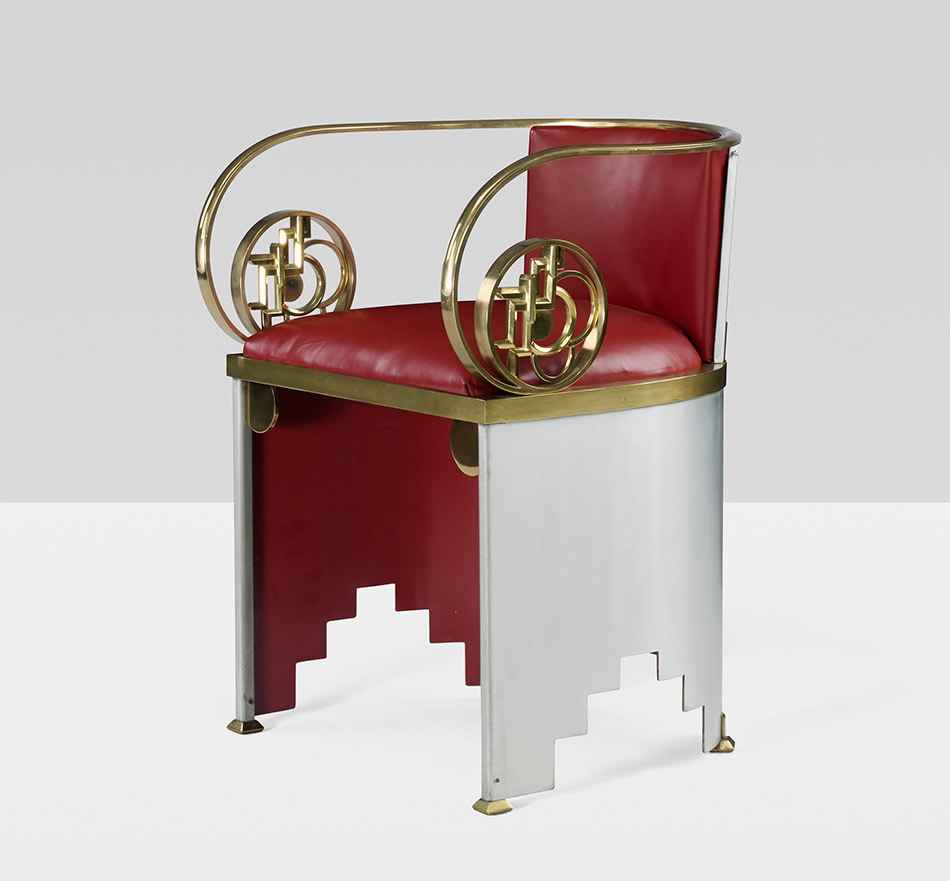 Armchair from the International Exposition of Art and Industry, 1928. Walter von Nessen (American, b. Germany, 1889–1943). Aluminum, brass, leather; 68.6 x 50.8 x 50.8 cm. Private collection. Photo: courtesy of Wright.
Armchair from the International Exposition of Art and Industry, 1928. Walter von Nessen (American, b. Germany, 1889–1943). Aluminum, brass, leather; 68.6 x 50.8 x 50.8 cm. Private collection. Photo: courtesy of Wright.
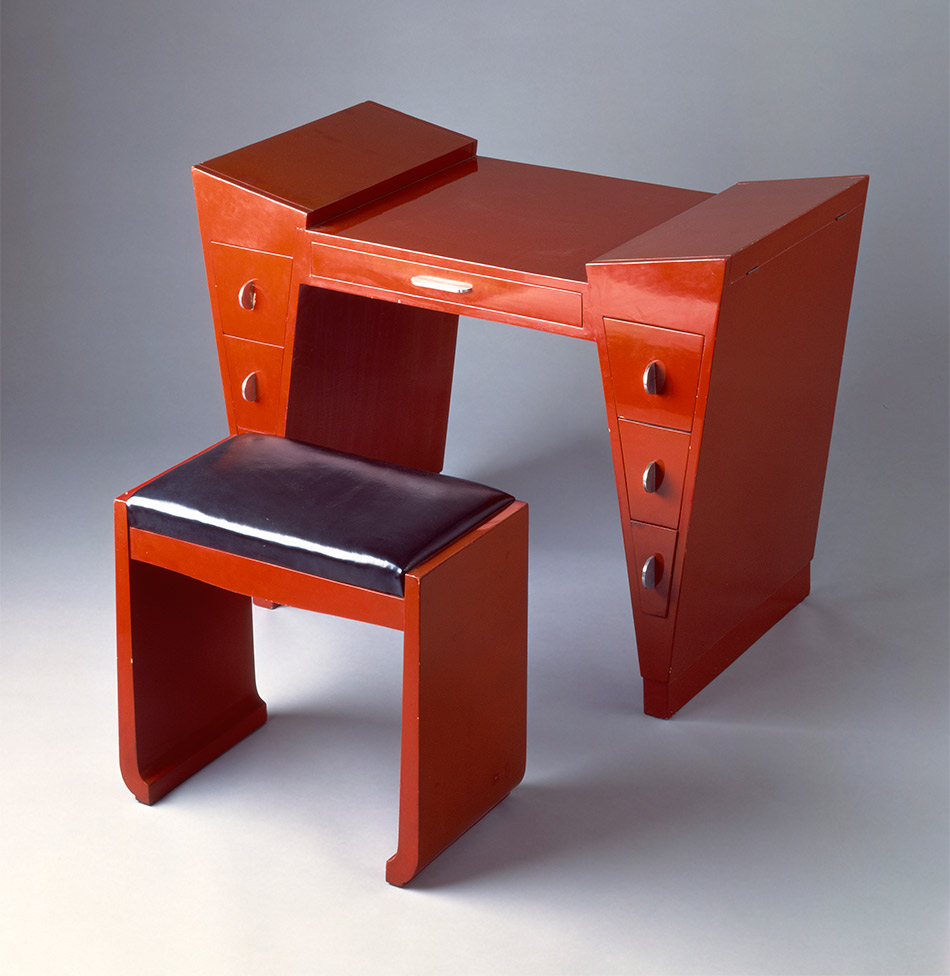 Dressing Table and Bench, c. 1929. After Léon Jallot (French, 1874–1967). Lord & Taylor (American, New York, est. 1826), retailer. Lacquered joined wood, mirror glass, metal; table: 79.3 x 105.4 x 60.3 cm; bench: 49.5 x 54.8 x 31.5 cm. Cooper Hewitt, Smithsonian Design Museum, Gift of James M. Osborn, 1969-97-7a/i.
Dressing Table and Bench, c. 1929. After Léon Jallot (French, 1874–1967). Lord & Taylor (American, New York, est. 1826), retailer. Lacquered joined wood, mirror glass, metal; table: 79.3 x 105.4 x 60.3 cm; bench: 49.5 x 54.8 x 31.5 cm. Cooper Hewitt, Smithsonian Design Museum, Gift of James M. Osborn, 1969-97-7a/i.
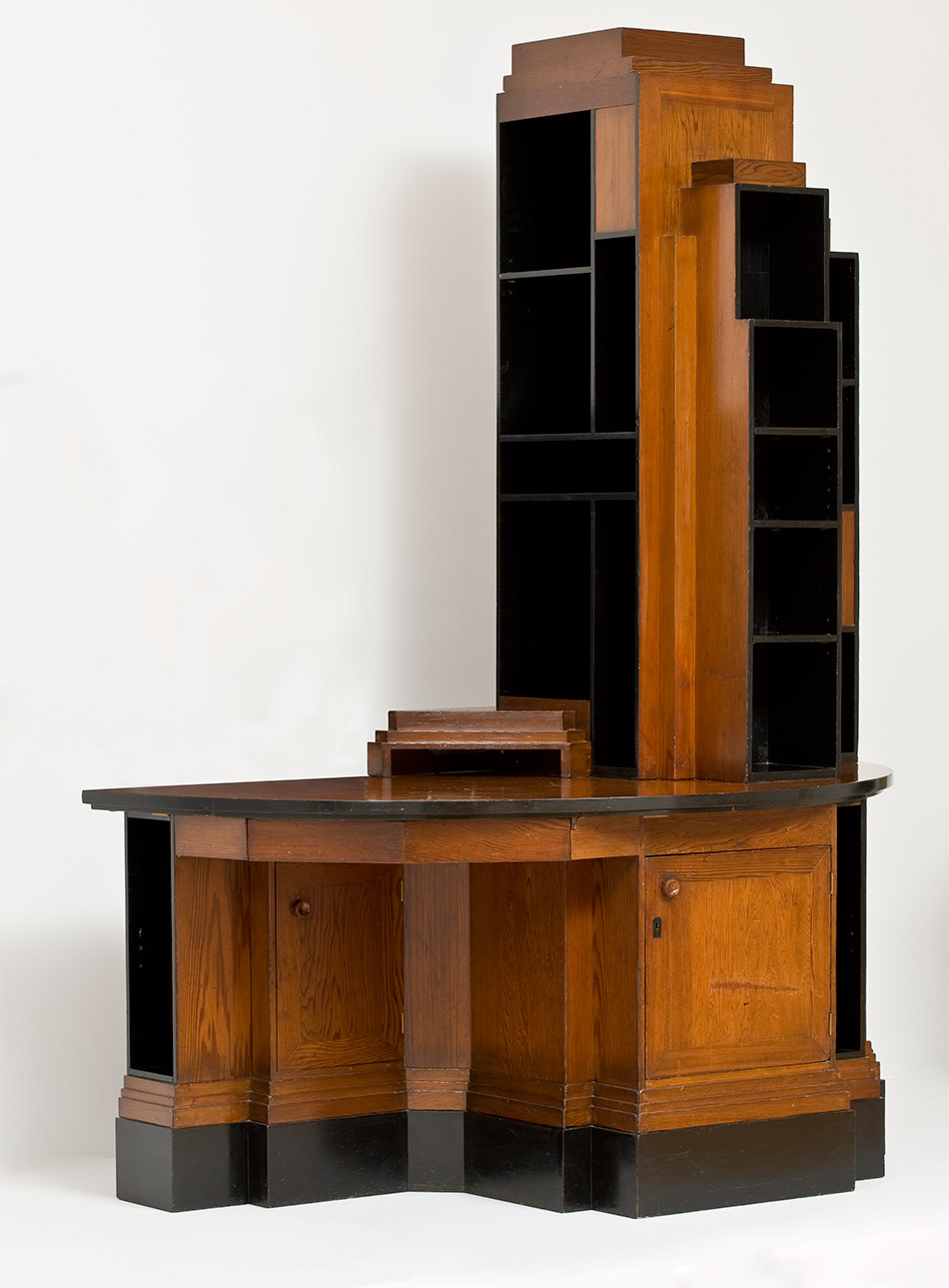 Paul T. Frankl (American, b. Austria, 1886–1958) Skyscraper Bookcase Desk, c. 1928. California redwood, black lacquer,
Paul T. Frankl (American, b. Austria, 1886–1958) Skyscraper Bookcase Desk, c. 1928. California redwood, black lacquer,
219.7 x 163.8 x 85.1 cm. Grand Rapids Art Museum, Gift of Dr. and Mrs. John Halick, 1984.7.2
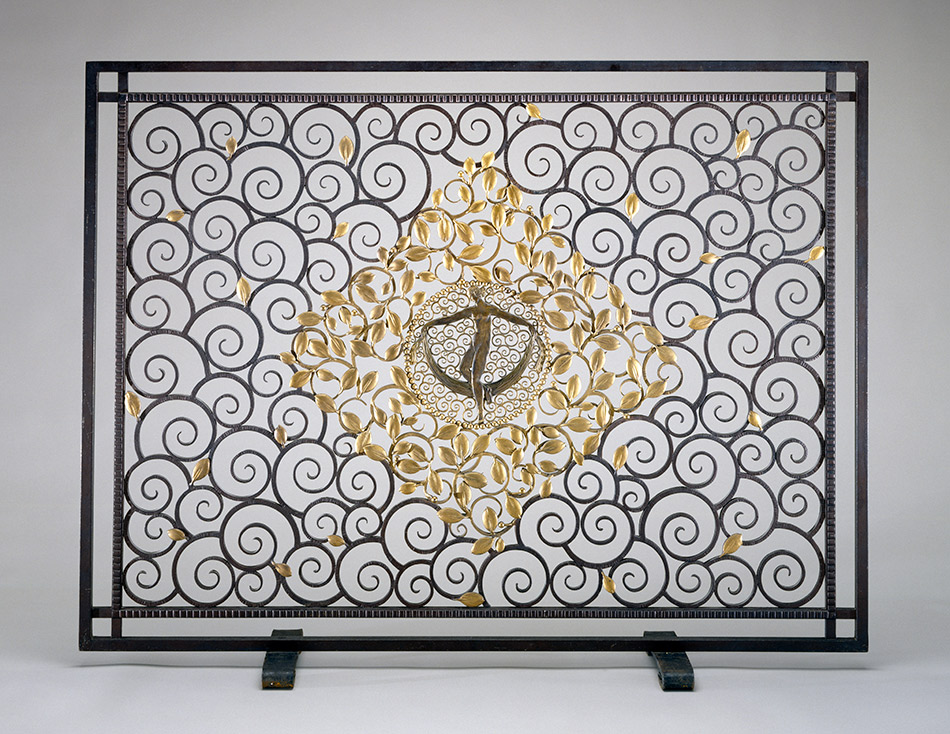 Edgar Brandt (French, 1880–1960) Fire Screen, c. 1925 Wrought iron and gilding 94.8 x 122.4 x 22.9 cm. The Museum of Fine Arts, Houston, Museum purchase funded by the Design Council, 2001, 2001.257
Edgar Brandt (French, 1880–1960) Fire Screen, c. 1925 Wrought iron and gilding 94.8 x 122.4 x 22.9 cm. The Museum of Fine Arts, Houston, Museum purchase funded by the Design Council, 2001, 2001.257
Installation views of The Jazz Age: American Style in the 1920s
Photos by David Brichford, courtesy of the Cleveland Museum of Art
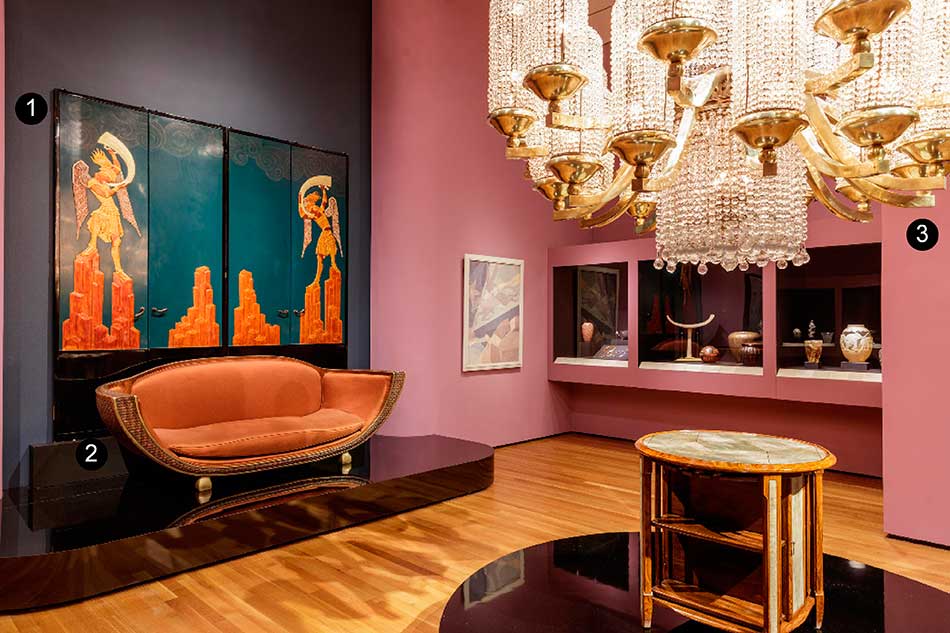 1. Séraphin Soudbinine (French, b. Russia, 1870–1944) Jean Dunand (French, b. Switzerland, 1877–1942), maker. Pair of Doors for the Music Room of Mr. and Mrs. Solomon Guggenheim, 1925–26. Carved, joined, and lacquered wood, eggshell, mother-ofpearl, gold leaf, cast bronze, 271.2 x 65.9 x 7.6 cm. Cooper Hewitt, Smithsonian Design Museum, Gift of Mrs. Solomon R. Guggenheim, 1950-104-1/4.
1. Séraphin Soudbinine (French, b. Russia, 1870–1944) Jean Dunand (French, b. Switzerland, 1877–1942), maker. Pair of Doors for the Music Room of Mr. and Mrs. Solomon Guggenheim, 1925–26. Carved, joined, and lacquered wood, eggshell, mother-ofpearl, gold leaf, cast bronze, 271.2 x 65.9 x 7.6 cm. Cooper Hewitt, Smithsonian Design Museum, Gift of Mrs. Solomon R. Guggenheim, 1950-104-1/4.
2. Marcel Coard (French, 1889–1975) Canapé Gondole, c. 1925. Carved Indian rosewood, Indian rosewood-veneered wood, brass, linen velvet, 92.3 x 247.5 x 87 cm Private Midwest collection.
3. Baccarat (French, Baccarat, est. 1764) Georges Chevalier (French, 1894–1987), designer Christofle (French, Paris, est. 1830), frame. Chandelier, 1925. Glass, metal h. 274 cm, diam. 167 cm Private collection.
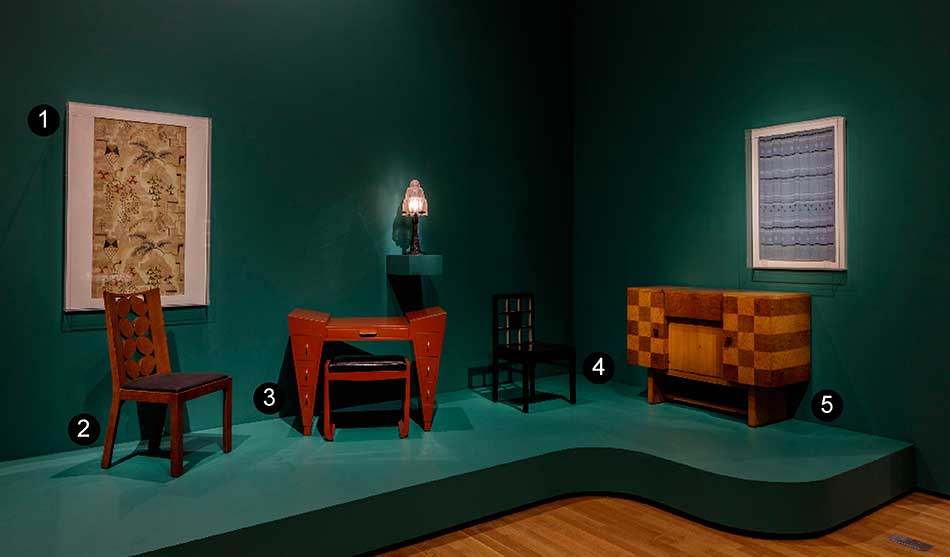
1. Charles Burchfield (American, 1893–1967) M. H. Birge & Sons Company (American, Buffalo, NY, 1834–1982), manufacturer. Modernistic Wallpaper, 1927. Machine-printed on embossed paper, 118 x 56 cm. Cooper Hewitt, Smithsonian Design Museum, Gift of Edna Lindemann, 1992-109-3
2. Claggett Wilson (American, 1887–1952) Dining Chair, Dining Room of Adolph Lewisohn, New York, 1925. Bird’s-eye maple, black fabric 99 x 49.2 x 55.9 cm. Collection of John C. Waddell.
3. Dressing Table and Bench, c. 1929. After Léon Jallot (French, 1874–1967). Lord & Taylor (American, New York, est. 1826), retailer. Lacquered joined wood, mirror glass, metal; table: 79.3 x 105.4 x 60.3 cm; bench: 49.5 x 54.8 x 31.5 cm. Cooper Hewitt, Smithsonian Design Museum, Gift of James M. Osborn, 1969-97-7a/i.
4. Joseph Urban (American, b. Austria, 1872–1933) Side Chair, c. 1925. Painted wood 86 x 52.5 x 45.3 cm. Cooper Hewitt, Smithsonian Design Museum, Gift of Dorothy S. Teegen and Carola Teegen Walton in memory of Otto J. Teegen, 1985-13-
5. Eugene Schoen (American, 1880–1957) Schmieg, Hungate & Kotzian (American, New York, est. 1908), maker. Cabinet, c. 1930. Thuja burls, primavera, Coromandel ebony, 91.4 x 121.9 x 53.3 cm. Milwaukee Art Museum, Purchase, with funds from the Demmer Charitable Trust, M2015.36
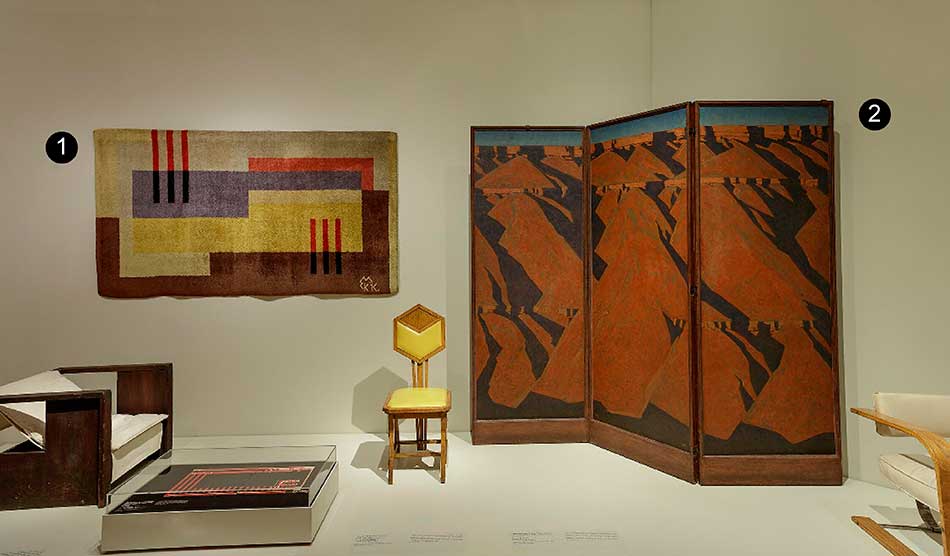 1. Edward McKnight Kauffer (American, 1890–1954) Wilton Royal Carpet Factory Ltd. (British, Wilton, est. 1740), manufacture. Carpet, 1929. Hemp and wool: plain weave with supplementary wrapping wefts forming cut solid pile through a technique known as “Ghiordes knots” , 213.3 x 119.8 cm. The Art Institute of Chicago, Royalties from the Warner Fund, 1987.21.
1. Edward McKnight Kauffer (American, 1890–1954) Wilton Royal Carpet Factory Ltd. (British, Wilton, est. 1740), manufacture. Carpet, 1929. Hemp and wool: plain weave with supplementary wrapping wefts forming cut solid pile through a technique known as “Ghiordes knots” , 213.3 x 119.8 cm. The Art Institute of Chicago, Royalties from the Warner Fund, 1987.21.
2. Maynard Dixon (American, 1875–1946) Study in Cubist Realism Screen, 1925. Oil on wood panel, California redwood, black lacquer, 200.7 x 236.2 cm. Denver Art Museum Collection: Lent by Grant and Betty Hagestad, 43.2009
 1. Émile-Jacques Ruhlmann (French, 1879–1933) Tibattant Desk, c. 1923. Macassar ebony, ivory, leather, aluminum leaf, silver, silk, oak, lumber-core plywood, poplar, mahogany, 112.4 x 59.1 x 39.4 cm. The Metropolitan Museum of Art, Purchase, Edward C. Moore Jr. Gift, 1923, 23.174. Image: © The Metropolitan Museum of Art. Image source: Art Resource, NY.
1. Émile-Jacques Ruhlmann (French, 1879–1933) Tibattant Desk, c. 1923. Macassar ebony, ivory, leather, aluminum leaf, silver, silk, oak, lumber-core plywood, poplar, mahogany, 112.4 x 59.1 x 39.4 cm. The Metropolitan Museum of Art, Purchase, Edward C. Moore Jr. Gift, 1923, 23.174. Image: © The Metropolitan Museum of Art. Image source: Art Resource, NY.
2. Corner Cabinet, c. 1923. Émile-Jacques Ruhlmann (French, 1879–1933). Kingwood (amaranth) veneer on mahogany, ivory inlay; 126.7 x 80.6 x 59.7 cm. Brooklyn Museum, Purchased with funds given by Joseph F. McCrindle, Mrs. Richard M. Palmer, Charles C. Paterson, Raymond Worgelt, and an anonymous donor, 71.150.1. Photo: Brooklyn Museum.
3. Thomas Lamb (American, 1896–1988) Textile, 1920–29 Screen-printed linen. 312.4 x 87 cm. Cooper Hewitt, Smithsonian Design Museum, Museum purchase through gift of Mrs. William Goulding, 2003-7-2
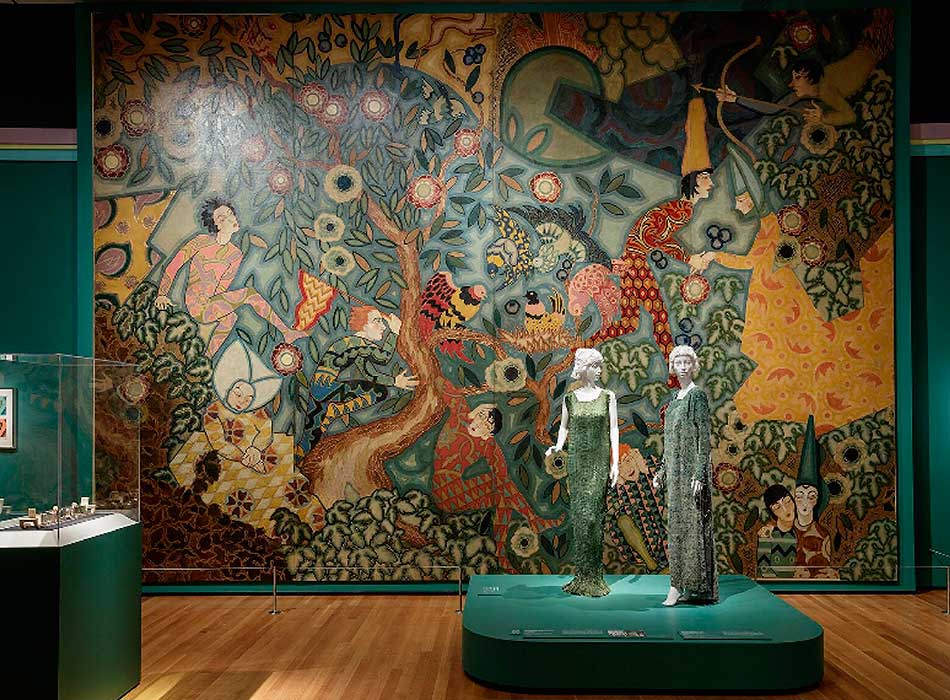 Joseph Urban (American, b. Austria, 1872–1933) Mural Panels for the Ziegfeld Theatre: The Joy of Life, 1927. Oil on canvas 518.5 x 729 x 1.6 cm The Collection of Richard H. Driehaus, Chicago
Joseph Urban (American, b. Austria, 1872–1933) Mural Panels for the Ziegfeld Theatre: The Joy of Life, 1927. Oil on canvas 518.5 x 729 x 1.6 cm The Collection of Richard H. Driehaus, Chicago
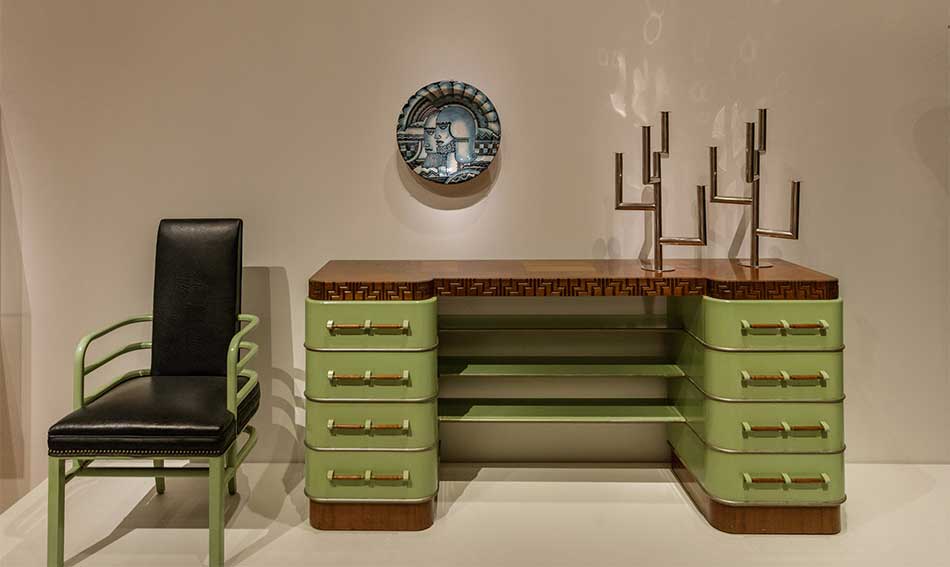 ARMCHAIR: Kem (Karl Emanuel Martin) Weber (American, b. Germany, 1889–1963) Grand Rapids Chair Company (American, Grand Rapids, MI, 1872–1973), manufacturer. Armchair from the Kem Weber Group, designed 1928–29. Painted wood, synthetic leather, 105.4 x 53.4 x 50.8 cm. The Cleveland Museum of Art, The Mary Spedding Milliken Memorial Fund, 2003.4.1.
ARMCHAIR: Kem (Karl Emanuel Martin) Weber (American, b. Germany, 1889–1963) Grand Rapids Chair Company (American, Grand Rapids, MI, 1872–1973), manufacturer. Armchair from the Kem Weber Group, designed 1928–29. Painted wood, synthetic leather, 105.4 x 53.4 x 50.8 cm. The Cleveland Museum of Art, The Mary Spedding Milliken Memorial Fund, 2003.4.1.
SIDEBOARD: Kem (Karl Emanuel Martin) Weber (American, b. Germany, 1889–1963) Sideboard from the Kem Weber Group, 1928–29. Sage green painted wood 83.9 x 182.8 x 48.3 cm. The Cleveland Museum of Art, The Mary Spedding Milliken Memorial Fund, 2003.4.2.
CANDLESTICKS: Hagenauer Werkstätte (Austrian, Vienna, 1898–1987) Kaktus Candlesticks, c. 1930. Nickel-plated brass h. 58.7–59.7 cm Private Midwest collection.
The Persistence of Traditional “Good Taste”
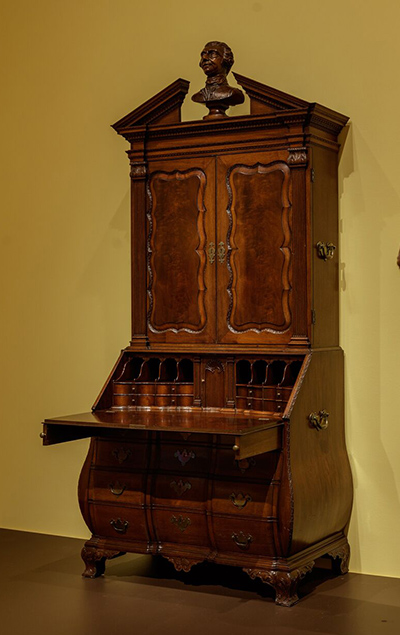 Works that show how Americans equated “good taste” and social success with older European styles of design, a trend showcased through some of the finest colonial revival decorative arts produced in America.Antiquing became a national pastime and, along with the purchase of historic reproductions, formed the cornerstone of traditional American decor.
Works that show how Americans equated “good taste” and social success with older European styles of design, a trend showcased through some of the finest colonial revival decorative arts produced in America.Antiquing became a national pastime and, along with the purchase of historic reproductions, formed the cornerstone of traditional American decor.
Desk and Bookcase, 1926, Mahogany, glass, brass 248.9 x 116.8 x 63.5 cm. Probably made by the Company of Master Craftsmen (American, New York, 1926–49) W. & J. Sloane (American, New York, 1843–1985), retailer. Fenimore Art Museum, Cooperstown, NY, Museum Purchase, acquired with funds provided by Horace Moses, N30003.1994. Photo by David Brichford
TOWARD A MACHINE AGE
Highlights the technological and stylistic innovations of the 1920s that became widespread in America by the early 1930s. Modern design of pure form and minimal decoration fit the era’s innovations in new technology and industrial materials, such as tubular steel, rubber, plastics and chrome. Revolutionary advancements in transportation were accompanied by new aerodynamic designs that emphasized speed. The popularity of this aesthetic informed the look of both luxury goods and everyday objects, heralding a new age of machines.
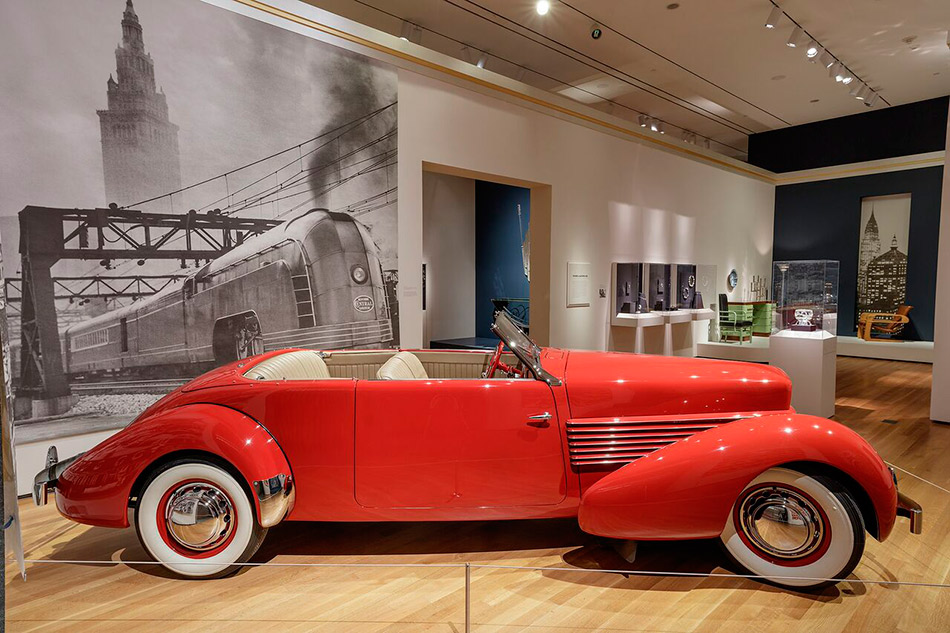 Auburn Automobile Company (American, Auburn, IN, 1900–1937) Manufactured in Connorsville, IN Cord 812. Phaeton Roadster, 1937 Steel, rubber, leather 5′ high x 16’5″ long x 5’10”, wide; 3,715 lbs. For caption: l. 488 cm. Pamela and B. Scott Isquick
Auburn Automobile Company (American, Auburn, IN, 1900–1937) Manufactured in Connorsville, IN Cord 812. Phaeton Roadster, 1937 Steel, rubber, leather 5′ high x 16’5″ long x 5’10”, wide; 3,715 lbs. For caption: l. 488 cm. Pamela and B. Scott Isquick
 “A New York Central Mercury train is dwarfed by Cleveland’s Union Station, November 1936, by J. Baylor Roberts, National Geographic”
“A New York Central Mercury train is dwarfed by Cleveland’s Union Station, November 1936, by J. Baylor Roberts, National Geographic”
COMPLEMENTARY ACTIVITIES
Exhibition CD
Exhibition: From Riches to Rags: American Photography in the Depression
Jazz Café Performances
Bus Tour: Cleveland Architecture of the Jazz Age
Docent Guided Tours
Gallery Talks. A Series of Gallery Talks with Stephen Harrison, Curator of Decorative Art and Design
Special Events
Lectures
Performance
Films
STATEMENTS
 William Griswold
William Griswold
Director of the Cleveland Museum of Art
“The Jazz Age: American Style in the 1920s is a blockbuster show—gorgeous, bountiful, exhilarating,”. “The exhibition explores the creative impulses that shaped American taste in that dynamic era, as well as new ideas that challenged the status quo and a desire for change in art and design. We are excited to give our visitors an inside look at this glorious age of innovation and artistic expression.”
 Stephen Harrison
Stephen Harrison
Curator of decorative art and design
“Nowhere else can be seen under one roof such an extraordinary group of design masterworks, which formed the essence of American style in the first half of the 20th century, than in this exhibition,”
“Some of these rare pieces represent recent discoveries. Others are owned privately and have not been seen publicly since they were made in the 1920s. These works pushed the boundaries of art and design in an age when people were hungry for change.”
CATALOGUE
 Authors:
Authors:
Sarah D. Coffin and Stephen Harrison
470 color and 44 archival black & white images
400 pages
9 x 10 in.
Published 2017
Softcover $40.00
Hardcover $60.00
The decade known as the Jazz Age was a time of growth and fortune, oppression and revolution. Spurred by innovation and the audacity of youth, architects, artists, musicians, filmmakers, and designers alike created unprecedented responses to the demand for a new American lifestyle; some looked back for inspiration, and others marched forward with ideas for a fresh vocabulary to voice the optimism of the day.
Lavishly illustrated with hundreds of full-color illustrations and featuring essays by two leading historians of decorative art and design, “The Jazz Age: American Style in the 1920s” reveals how designers established a new visual representation of modernity within the context of a changing world.
ORGANIZERS
Co-organized by the Cleveland Museum of Art and the Cooper Hewitt, Smithsonian Design Museum, New York.
Presenting Sponsors
Dealer Tire
Marshall and Brenda Brown
Jane and Doug Kern
Bill and Joyce Litzler
Special Thanks
Barbara Deisroth
Sandra and Richey Smith
Howard Hanna Real Estate
Terry Kovel
Media Partner
WKYC-TV
The Cleveland Museum of Art is generously funded by Cuyahoga County residents through Cuyahoga Arts and Culture. The Ohio Arts Council helped fund this exhibition with state tax dollars to encourage economic growth, educational excellence, and cultural enrichment for all Ohioans.
THE CLEVELAND MUSEUM OF ART
11150 East Boulevard, Cleveland, Ohio 44106
For more information call 888-CMA-0033
www.ClevelandArt.org.
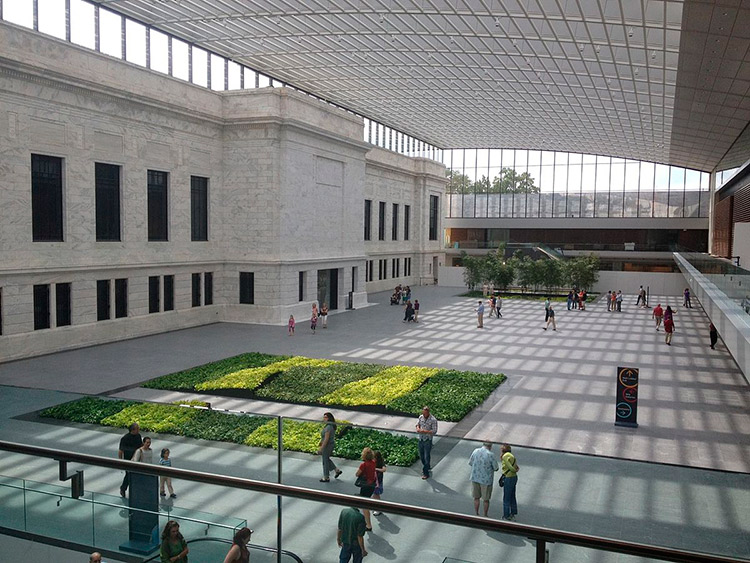
About the Cleveland Museum of Art
The Cleveland Museum of Art is renowned for the quality and breadth of its collection, which includes almost 45,000 objects and spans 6,000 years of achievement in the arts. The museum is a significant international forum for exhibitions, scholarship, performing arts and art education and recently completed an ambitious, multi-phase renovation and expansion project across its campus. One of the top comprehensive art museums in the nation and free of charge to all, the Cleveland Museum of Art is located in the dynamic University Circle neighborhood.
The Cleveland Museum of Art is supported by a broad range of individuals, foundations and businesses in Cleveland and Northeast Ohio. The museum is generously funded by Cuyahoga County residents through Cuyahoga Arts and Culture. Additional support comes from the Ohio Arts Council, which helps fund the museum with state tax dollars to encourage economic growth, educational excellence and cultural enrichment for all Ohioans. For three consecutive years, the museum has been awarded a top four-star rating by Charity Navigator, the nation’s most-utilized independent evaluator of charities and nonprofits. For more information about the museum, its holdings, programs and events, call 888-CMA-0033 or visit